Don't wanna be here? Send us removal request.
Text
5 Key Skills for Hiring Dedicated Developers
Introduction
In today's fast-paced tech industry, finding the right developers can make or break your project. Are you ready to discover the top skills that will set your team apart? In the competitive world of software development, hiring dedicated developers with the right skills ensures that your team can tackle challenges efficiently and deliver high-quality results. This blog explores the top five skills to look for when hiring dedicated developers, providing insights and tips to help you make the best hiring decisions.
Technical Proficiency for Hiring Dedicated Developers
The cornerstone of any developer's skill set is their technical proficiency. Ensuring that your dedicated developers possess strong technical skills is paramount to the success of your projects. This section delves into the essential technical skills that a dedicated developer must possess, including proficiency in programming languages, an understanding of development frameworks, and familiarity with version control systems.
Proficiency in Programming Languages
Core Languages: A dedicated developer should be proficient in core programming languages relevant to your projects, such as Python, JavaScript, Java, C++, or Ruby. Mastery of these languages enables developers to write clean, efficient, and maintainable code.
Language Versatility: Developers who are comfortable with multiple programming languages can adapt to different project requirements and technology stacks, making them versatile team members.
Understanding of Development Frameworks
Framework Expertise: Proficiency in popular development frameworks like React, Angular, Django, or Spring is essential. These frameworks provide a structured approach to development, helping developers build robust and scalable applications.
Best Practices: Familiarity with best practices and design patterns associated with these frameworks ensures that developers can leverage them to their full potential, resulting in efficient and high-quality code.
Familiarity with Version Control Systems
Git Proficiency: Knowledge of version control systems, particularly Git, is crucial. Git allows developers to manage and track changes to code, collaborate effectively with team members, and maintain a history of project development.
Branching Strategies: Understanding branching strategies and workflows, such as GitFlow, helps developers manage features, bug fixes, and releases efficiently, contributing to a streamlined development process.
Problem-Solving Abilities

Great developers are excellent problem solvers. Their ability to navigate complex challenges and find effective solutions is a key indicator of their potential success on your team. This section highlights the importance of analytical thinking and creativity in troubleshooting and optimizing code. It also discusses methods to assess a candidate’s problem-solving skills during the interview process.
Analytical Thinking
Understanding Complex Problems: A strong developer can break down complex problems into manageable parts, making it easier to identify the root cause and develop a solution.
Logical Reasoning: Analytical thinking involves logical reasoning, which helps developers systematically approach problems and devise efficient solutions.
Creativity in Troubleshooting
Innovative Solutions: Creativity is essential for troubleshooting because it enables developers to think outside the box and come up with innovative solutions to challenging issues.
Adaptability: Creative developers can adapt to unexpected problems and quickly find alternative solutions, ensuring minimal disruption to the development process.
Optimizing Code
Efficiency Improvements: Problem-solving skills are crucial for optimizing code. Developers must identify inefficiencies and refactor code to improve performance.
Scalability Considerations: A good problem solver can design solutions that not only fix current issues but also scale effectively as the project grows.
Assessing Problem-Solving Skills During Interviews
Technical Challenges: Present candidates with real-world technical challenges during the interview process. This allows you to observe their approach to problem-solving and their ability to think under pressure.
Behavioral Questions: Ask behavioral questions that reveal how candidates have handled difficult situations in the past. This can provide insight into their problem-solving process and adaptability.
Coding Tests: Use coding tests that focus on problem-solving rather than just syntax. These tests should challenge candidates to devise efficient and effective solutions to programming problems.
Incorporating a thorough assessment of problem-solving abilities into your hiring process ensures that you select developers who can effectively tackle the challenges that arise during development.
Communication Skills

Effective communication is vital in collaborative environments, significantly influencing a developer's ability to contribute to a team's success. This section explores how strong verbal and written communication skills enhance a developer's ability to work well within a team, understand project requirements, and document their work clearly.
Team Collaboration
Clear Interaction: Developers with excellent communication skills can clearly convey their ideas and understand others, fostering a more cohesive and productive team environment.
Active Listening: Good communicators are also active listeners, which helps in understanding different perspectives and integrating diverse ideas into the project.
Understanding Project Requirements
Requirement Gathering: Strong communication skills are essential for accurately gathering and interpreting project requirements from stakeholders, ensuring that the development aligns with the client's needs and expectations.
Clarification: Developers who communicate effectively can ask the right questions to clarify any ambiguities, preventing misunderstandings and ensuring a smoother workflow.
Documentation
Clear Documentation: Effective written communication is crucial for creating clear and comprehensive documentation, which serves as a reference for current and future developers working on the project.
Knowledge Sharing: Well-documented code and processes facilitate knowledge sharing within the team, making it easier for new members to get up to speed and for existing members to understand and maintain the project.
Incorporating developers with strong communication skills into your team enhances collaboration, ensures accurate understanding of project requirements, and results in clear, effective documentation. These capabilities are essential for the smooth functioning and success of any development project.
Adaptability and Continuous Learning

The tech landscape is ever-changing, and developers need to keep up with the latest trends and technologies to remain effective and innovative. This section discusses the importance of adaptability and a commitment to continuous learning, providing tips on how to identify candidates who are passionate about their professional growth.
Importance of Adaptability
Embracing Change: Adaptability is crucial for developers to efficiently handle evolving project requirements, new technologies, and unexpected challenges.
Flexible Mindset: Developers who are adaptable can quickly learn new skills and tools, making them invaluable assets to any team facing rapid technological advancements.
Commitment to Continuous Learning
Staying Updated: Continuous learning ensures that developers stay informed about the latest industry trends, best practices, and emerging technologies, enabling them to implement the most effective solutions.
Skill Enhancement: A commitment to learning helps developers enhance their existing skills and acquire new ones, contributing to their overall professional growth and the success of their projects.
Identifying Passionate Candidates
Learning Initiatives: Look for candidates who actively engage in learning through online courses, certifications, workshops, or attending tech conferences. This demonstrates their dedication to staying current and improving their skills.
Project Involvement: Evaluate candidates' involvement in personal or open-source projects, which can indicate their enthusiasm for exploring new technologies and applying their knowledge in practical scenarios.
Professional Networks: Candidates who participate in professional networks or tech communities often have a broader perspective on industry trends and are more likely to be up-to-date with the latest advancements.
Incorporating developers who exhibit adaptability and a commitment to continuous learning into your team ensures that you are always equipped with the latest knowledge and skills, enabling your projects to stay ahead in the fast-paced tech industry.
Team Player Attitude

Beyond technical skills, a dedicated developer must be a good team player. This section explores the significance of teamwork, including collaboration, reliability, and a positive attitude. It also offers strategies for evaluating a candidate's ability to fit into your company culture.
Collaboration
Effective Collaboration: Team players work well with others, actively participate in discussions, and contribute to a collaborative environment. They are open to feedback and willing to share their knowledge and expertise.
Cross-Functional Teams: Developers who can collaborate effectively with cross-functional teams, including designers, testers, and project managers, help ensure the smooth progression of projects and the integration of diverse perspectives.
Reliability
Dependability: Reliability is crucial in a team setting. Reliable developers consistently meet deadlines, deliver high-quality work, and can be counted on to follow through on their commitments.
Accountability: Good team players take responsibility for their tasks and are accountable for their actions. They acknowledge mistakes and work proactively to find solutions.
Positive Attitude
Constructive Mindset: A positive attitude fosters a constructive work environment. Developers who maintain a positive outlook are more likely to overcome challenges effectively and contribute to a motivating team atmosphere.
Encouraging Others: Team players with a positive attitude often encourage and support their colleagues, helping to build a strong, cohesive team.
Evaluating Team Player Attitude
Behavioral Interviews: Conduct behavioral interviews to assess how candidates have worked in teams in the past. Ask questions about their experiences with collaboration, handling conflicts, and supporting team members.
Cultural Fit: Evaluate candidates for cultural fit by discussing your company's values and observing how they align with the candidate's attitudes and behaviors.
Reference Checks: Contact previous employers or colleagues to gain insights into the candidate's reliability, collaboration skills, and overall attitude in a team setting.
By focusing on hiring developers who are strong team players, you can build a harmonious and productive team environment. Collaboration, reliability, and a positive attitude are key qualities that contribute to the success of your development projects and the overall health of your company culture.
Conclusion
In summary, hiring dedicated developers requires a keen focus on several key skills to ensure the success of your projects and the strength of your team. These essential skills include technical proficiency, problem-solving abilities, strong communication skills, adaptability and continuous learning, and a team player attitude.
Technical Proficiency: Ensure candidates are well-versed in relevant programming languages, development frameworks, and version control systems.
Problem-Solving Abilities: Look for developers who demonstrate strong analytical thinking, creativity in troubleshooting, and code optimization skills.
Communication Skills: Prioritize candidates with excellent verbal and written communication skills to enhance team collaboration and project clarity.
Adaptability and Continuous Learning: Choose developers who are adaptable and committed to continuous learning to stay ahead of industry trends and technological advancements.
Team Player Attitude: Emphasize the importance of teamwork, reliability, and a positive attitude to foster a collaborative and supportive team environment.
By prioritizing these skills in your hiring process, you can build a strong, capable development team that is well-equipped to handle the challenges of the ever-evolving tech landscape. Investing in developers with these qualities will not only enhance your projects' success but also contribute to a positive and productive company culture.
0 notes
Text
How Developers Enhance Cybersecurity
Introduction
In today's digital age, cybersecurity is a critical concern for individuals, businesses, and governments. As technology advances, so does the threat landscape, making robust cybersecurity measures more essential than ever. With cyberattacks becoming increasingly sophisticated, the need to protect sensitive data and maintain privacy has never been more paramount.
Developers play a pivotal role in this cybersecurity ecosystem. By integrating secure coding practices and continuously updating their knowledge on the latest threats, developers can significantly enhance the security posture of the applications and systems they create. Their proactive efforts in identifying vulnerabilities and implementing robust security protocols are crucial in safeguarding our digital world against malicious attacks.
Understanding Cybersecurity

Cybersecurity refers to the practice of protecting systems, networks, and programs from digital attacks. These cyberattacks are typically aimed at accessing, changing, or destroying sensitive information, extorting money from users, or interrupting normal business processes. Key components of cybersecurity include:
Network Security: Protecting the integrity of the network and the data transmitted through it, preventing unauthorized access, and ensuring reliable operation.
Application Security: Keeping software and devices free of threats, incorporating security features during development to prevent vulnerabilities.
Information Security: Ensuring the confidentiality, integrity, and availability of data, both in storage and in transit.
Operational Security: Processes and decisions for handling and protecting data assets.
The relevance of cybersecurity in modern technology cannot be overstated. As the world becomes more interconnected through the Internet of Things (IoT), cloud computing, and mobile networks, the potential attack surfaces expand, making robust cybersecurity measures vital. Effective cybersecurity practices are essential to protect against financial loss, damage to reputation, and legal ramifications resulting from data breaches and cyberattacks. In essence, cybersecurity is a foundational element in maintaining trust and security in today's digital landscape.
Role of Developers in Cybersecurity

Developers hold a crucial responsibility in maintaining and enhancing cybersecurity through the creation of secure code. Their role begins at the initial stages of software development and extends throughout the entire lifecycle of the application. One of their primary responsibilities is to integrate security into the design and development process, often referred to as the Secure Software Development Lifecycle (SDLC). By adopting secure coding practices, developers can minimize vulnerabilities and reduce the risk of exploitation.
Specific areas where developers can significantly impact cybersecurity include:
Code Review and Testing: Regularly reviewing and testing code for vulnerabilities is essential. Developers should utilize static and dynamic analysis tools to identify and rectify security flaws before the code is deployed.
Input Validation and Sanitization: Ensuring that all user inputs are properly validated and sanitized can prevent common attacks like SQL injection and cross-site scripting (XSS). By implementing strict input validation rules, developers can thwart malicious attempts to exploit application vulnerabilities.
Authentication and Authorization: Implement robust authentication and authorization mechanisms to ensure that only authorized users can access sensitive data and functionalities. This includes using strong password policies, multi-factor authentication, and proper session management.
Encryption: Protecting data at rest and in transit through encryption is vital. Developers should use industry-standard encryption protocols to safeguard sensitive information from unauthorized access and interception.
Regular Updates and Patch Management: Keeping software and libraries up-to-date with the latest security patches is crucial. Developers should establish a process for timely updates to address newly discovered vulnerabilities.
By focusing on these areas, developers can significantly contribute to the overall cybersecurity posture of their applications, ensuring a safer digital environment for users.
Secure Coding Practices

Writing secure code is essential to safeguarding applications from malicious attacks and ensuring the integrity, confidentiality, and availability of data. Secure coding practices help developers prevent vulnerabilities that can be exploited by attackers, thereby reducing the risk of data breaches, financial loss, and reputational damage.
Best Practices for Secure Coding:
Input Validation and Sanitization: Always validate and sanitize user inputs to prevent injection attacks such as SQL injection and cross-site scripting (XSS). By strictly validating inputs, developers can thwart attempts to manipulate application behavior through malicious data.
Authentication and Authorization: Implement strong authentication and authorization mechanisms. Enforce multi-factor authentication and ensure that access controls are properly configured to prevent unauthorized access to sensitive data.
Error Handling and Logging: Handle errors gracefully without exposing sensitive information. Ensure that logs do not contain sensitive data and that they are securely stored to prevent unauthorized access.
Data Encryption: Encrypt sensitive data both in transit and at rest. Use strong encryption algorithms and ensure that encryption keys are securely managed to protect data from unauthorized access and breaches.
Regular Code Reviews: Conduct regular code reviews and security testing to identify and fix vulnerabilities early. Use tools like static and dynamic analysis to automate the detection of security issues.
Common Vulnerabilities and How to Avoid Them:
SQL Injection: Occurs when attackers inject malicious SQL code into queries. To avoid this, developers should use prepared statements and parameterized queries, which separate SQL logic from data inputs.
Cross-Site Scripting (XSS): This vulnerability allows attackers to inject malicious scripts into web pages viewed by other users. Prevent XSS by properly escaping or sanitizing user inputs and using security headers like Content Security Policy (CSP).
Cross-Site Request Forgery (CSRF): This attack tricks users into performing actions they did not intend to. Protect against CSRF by implementing anti-CSRF tokens and verifying them on the server side.
By adhering to these secure coding practices, developers can significantly reduce the risk of code vulnerabilities and enhance the overall security of their applications, creating a safer digital environment for users.
Utilizing Security Tools and Software

In the quest for enhanced cybersecurity, a variety of tools and software are available to help developers identify and mitigate vulnerabilities. These tools play a critical role in fortifying applications against potential attacks and ensuring robust security measures are in place.
Key Security Tools and Software:
Static Application Security Testing (SAST): Tools like SonarQube and Fortify analyze source code for security vulnerabilities without executing the code. These tools are essential for early detection of potential security flaws during the development phase.
Dynamic Application Security Testing (DAST): Tools such as OWASP ZAP and Burp Suite test running applications to identify vulnerabilities like SQL injection and cross-site scripting (XSS). They simulate attacks to find exploitable weaknesses in a live environment.
Dependency Scanners: Tools like Snyk and Dependabot help manage and secure dependencies by scanning for known vulnerabilities in third-party libraries and frameworks, ensuring that all components used are secure.
Security Information and Event Management (SIEM): Solutions like Splunk and LogRhythm collect and analyze security data from various sources, providing real-time insights and alerts on potential security incidents.
Integrating Security Tools into Developer Workflows:
Developers can seamlessly integrate these tools into their workflows to enhance security. By incorporating SAST and DAST tools into continuous integration and continuous deployment (CI/CD) pipelines, security checks become an automated part of the development process. Dependency scanners can be configured to run regularly, ensuring that all dependencies are up-to-date and free from known vulnerabilities. Additionally, leveraging SIEM tools can provide continuous monitoring and prompt response to security threats, further securing the application lifecycle.
By utilizing these security tools, developers can proactively address security issues, creating more resilient and secure applications.
Regular Security Testing and Audits
Continuous security testing and audits are fundamental practices in maintaining the integrity and security of software applications. In an environment where cyber threats are constantly evolving, regular testing and auditing ensure that vulnerabilities are identified and addressed promptly, reducing the risk of exploitation.
Importance of Continuous Testing and Audits:
Early Detection: Identifying and mitigating vulnerabilities early in the development lifecycle.
Compliance: Ensuring compliance with industry standards and regulations.
Risk Management: Reducing the risk of data breaches, financial loss, and reputational damage.
Continuous Improvement: Providing feedback that helps improve security practices and policies over time.
Types of Security Testing:
Penetration Testing: This is an ethical hacking process where security experts simulate attacks to identify vulnerabilities. Penetration testing helps uncover weaknesses that could be exploited by attackers, providing a real-world perspective on the security posture of the application.
Static Application Security Testing (SAST): SAST tools analyze source code or compiled versions of code to find vulnerabilities without executing the code. This type of testing is essential for identifying flaws during the early stages of development, allowing for timely remediation.
Dynamic Application Security Testing (DAST): DAST involves testing a running application to identify vulnerabilities that could be exploited in a live environment. This type of testing simulates attacks and helps uncover issues that static analysis might miss.
Code Reviews: Regular code reviews by peers or automated tools help identify security issues and coding errors. This collaborative approach ensures that multiple sets of eyes examine the code, increasing the likelihood of detecting vulnerabilities.
Security Audits: Comprehensive audits involve a thorough examination of an organization's security policies, procedures, and controls. Security audits assess the effectiveness of existing measures and recommend improvements to enhance overall security.
By incorporating these various types of security testing and audits into their workflows, organizations can maintain a robust security posture. Regular testing and auditing not only help in identifying and addressing current vulnerabilities but also ensure that security practices evolve to meet new and emerging threats. This proactive approach is essential for safeguarding sensitive data and maintaining the trust of users and stakeholders.
Staying Updated with Security Trends
In the ever-evolving landscape of cybersecurity, staying current with the latest trends and threats is crucial for developers. The rapid pace of technological advancement means that new vulnerabilities and attack vectors are continually emerging. Developers must remain vigilant and informed to effectively protect their applications and data.
Importance of Staying Updated:
Proactive Defense: By keeping abreast of the latest security trends, developers can anticipate potential threats and implement preventative measures before vulnerabilities are exploited.
Improved Security Practices: Understanding emerging threats and new security techniques helps developers enhance their coding practices and integrate more robust security features.
Compliance and Standards: Staying updated ensures that developers meet industry standards and compliance requirements, avoiding legal and financial repercussions.
Resources and Communities for Keeping Updated:
Online Courses and Certifications: Platforms like Coursera, Udemy, and SANS Institute offer courses on the latest cybersecurity practices and certifications that help validate expertise.
Industry Blogs and News Sites: Websites such as Krebs on Security, Threatpost, and The Hacker News provide timely updates on cybersecurity trends and incidents.
Professional Communities: Joining forums and communities like Stack Overflow, Reddit’s cybersecurity subreddits, and the OWASP community allows developers to engage with peers, share knowledge, and discuss emerging threats.
Security Conferences and Webinars: Attending events like Black Hat, DEF CON, and RSA Conference provides insights into the latest research, tools, and techniques in cybersecurity.
Vendor Bulletins and Security Advisories: Subscribing to security advisories from vendors and organizations like Microsoft, Adobe, and the Cybersecurity and Infrastructure Security Agency (CISA) ensures developers receive timely updates on vulnerabilities and patches.
By leveraging these resources and actively participating in professional communities, developers can stay informed about the latest cybersecurity trends and threats, thereby enhancing their ability to secure applications and protect sensitive data effectively.
Training and Education
Ongoing training and education are vital for developers to stay ahead in the field of cybersecurity. The dynamic nature of cyber threats necessitates continuous learning to keep up with new vulnerabilities, attack vectors, and defensive strategies. By investing in regular training, developers can enhance their skills, improve their coding practices, and contribute more effectively to their organization’s security posture.
Importance of Ongoing Training and Education:
Skill Enhancement: Continuous education helps developers acquire new skills and update existing ones, ensuring they are equipped to tackle the latest security challenges.
Compliance and Best Practices: Regular training ensures developers adhere to industry standards and best practices, reducing the risk of security breaches.
Career Advancement: Earning certifications and attending workshops can lead to career growth and better job opportunities within the cybersecurity domain.
Beneficial Courses, Certifications, and Workshops:
Certified Information Systems Security Professional (CISSP): This globally recognized certification covers a broad range of cybersecurity topics, providing developers with a solid foundation in security practices and principles.
Certified Ethical Hacker (CEH): Offered by EC-Council, this certification focuses on identifying and addressing security weaknesses through ethical hacking techniques.
SANS Institute Training Programs: SANS offers various courses and certifications, such as the Global Information Assurance Certification (GIAC), tailored to different aspects of cybersecurity, including secure coding and incident handling.
OWASP Training: The Open Web Application Security Project (OWASP) provides resources and training focused on web application security, including workshops and online courses.
Coursera and Udemy Courses: Platforms like Coursera and Udemy offer a wide range of cybersecurity courses, from introductory to advanced levels, taught by industry experts.
By engaging in these educational opportunities, developers can remain proficient in the latest cybersecurity techniques and tools, ensuring they are well-prepared to protect their applications and data against evolving threats.
Collaboration and Communication
Effective communication and collaboration between development and security teams are critical to building secure applications. When these teams work together seamlessly, they can identify and address security issues early in the development process, leading to more robust and secure software.
Significance of Effective Collaboration:
Early Detection of Vulnerabilities: Collaboration ensures that security considerations are integrated from the outset, allowing potential vulnerabilities to be identified and mitigated during the development phase.
Shared Knowledge: Regular communication facilitates the exchange of expertise and knowledge, helping both teams stay informed about the latest threats and best practices.
Efficient Problem-Solving: A collaborative approach enables faster resolution of security issues, minimizing the impact on the development timeline and reducing the risk of breaches.
Tips for Fostering a Security-Focused Culture:
Regular Training and Workshops: Organize joint training sessions and workshops to keep both development and security teams updated on the latest cybersecurity trends and practices.
Integrated Security Processes: Embed security checkpoints within the development workflow, such as code reviews and automated security testing, to ensure continuous attention to security.
Open Communication Channels: Establish clear communication channels for reporting and discussing security concerns. Encourage a culture where raising security issues is welcomed and acted upon promptly.
Cross-Functional Teams: Form cross-functional teams that include members from both development and security to work on projects collaboratively, fostering a deeper understanding and mutual respect for each other’s roles.
By promoting effective communication and collaboration, organizations can create a security-focused culture that prioritizes the protection of applications and data, leading to more secure and resilient software solutions.
Final Thoughts
Cybersecurity is a paramount concern in today's digital world, requiring continuous vigilance and proactive measures. Developers play a crucial role in this ecosystem by writing secure code, utilizing advanced security tools, and integrating regular security testing and audits into their workflows. Staying updated with the latest cybersecurity trends and engaging in ongoing training and education are essential for maintaining a robust security posture. Effective communication and collaboration between development and security teams further enhance the security of applications. By embracing these practices, developers can significantly contribute to a safer digital environment, ensuring the protection of sensitive data and maintaining user trust. Continuous improvement and proactive security measures are key to staying ahead of evolving threats and safeguarding our digital future.
0 notes
Text
Guide to Transform Your Business with Developers
Introduction
In today's fast-paced digital era, leveraging developers is crucial for transforming and scaling your business. Technology and innovation serve as the backbone for business growth, driving efficiency, enhancing customer experiences, and opening new market opportunities. This blog will explore how skilled developers can revolutionize your operations, the pivotal role of cutting-edge technology, and practical strategies to integrate innovation into your business model. Get ready to unlock the potential of your business through the power of development and technology.

Understanding the Role of Developers
Developers are the architects of the digital world, playing a pivotal role in modern business by designing, building, and maintaining the software that drives operations and customer interactions. Their expertise ensures seamless functionality, innovative solutions, and competitive advantage.
Front-end Developers focus on the user interface and user experience (UI/UX). They create the visual elements that users interact with, ensuring an engaging and intuitive experience. By crafting responsive and aesthetically pleasing websites or applications, front-end developers directly impact customer satisfaction and retention.
Back-end Developers work behind the scenes, managing server-side logic, databases, and application integration. They ensure that everything runs smoothly and securely, handling data processing and transactions. Their work supports the functionality and performance of the front-end, making sure that users have a reliable experience.
Full-stack Developers combine both front-end and back-end expertise. They possess a comprehensive understanding of how the entire system works, allowing them to build and manage complete solutions. Full-stack developers offer versatility and efficiency, bridging the gap between design and functionality to accelerate business transformation.
Each type of developer contributes uniquely to business transformation. Front-end developers enhance user engagement, back-end developers ensure operational stability, and full-stack developers provide holistic solutions, driving overall business growth through technology and innovation.
Identifying Business Needs

Before hiring developers, it’s crucial to assess your business needs thoroughly. This process begins with a comprehensive business assessment to understand current challenges, operational gaps, and growth opportunities. By evaluating your existing systems, customer feedback, and market trends, you can identify specific areas where development can make a significant impact.
Aligning development goals with your business objectives is essential for success. Start by defining clear, measurable outcomes you want to achieve through development, such as improving user experience, increasing operational efficiency, or expanding your digital presence. Ensure these goals directly support your broader business strategies, whether it's scaling operations, enhancing customer engagement, or driving revenue growth.
Consider the following steps in your assessment:
Analyze Current Systems: Evaluate the effectiveness and limitations of your existing technology.
Identify Pain Points: Pinpoint areas where inefficiencies or customer dissatisfaction are evident.
Set Priorities: Determine which aspects of your business would benefit most from development efforts.
Consult Stakeholders: Engage with key stakeholders to gather insights and align on development priorities.
By aligning development goals with business objectives, you ensure that your investment in development not only addresses immediate needs but also propels your business toward its long-term vision. This strategic alignment maximizes the impact of your development efforts, driving sustainable growth and innovation.
Choosing the Right Development Team

Selecting the right developers or a development team is crucial for achieving your business objectives. Here are key criteria to consider when hiring developers:
Technical Expertise: Ensure candidates have the necessary technical skills for your project. This includes proficiency in relevant programming languages, frameworks, and tools.
Experience: Look for developers with a proven track record of successful projects. Review their portfolio and seek references from previous employers or clients.
Cultural Fit: Developers should align with your company’s values and work culture. This enhances collaboration and productivity.
Problem-Solving Ability: Assess their ability to solve complex problems creatively and efficiently.
Communication Skills: Effective communication is vital for understanding project requirements and collaborating with team members.
When choosing between in-house vs. outsourced developers, consider the following pros and cons:
In-House Developers:
Pros:
Better control and oversight over the development process.
Enhanced collaboration and integration with the existing team.
Immediate availability for support and updates.
Cons:
Higher costs due to salaries, benefits, and overheads.
Time-consuming hiring and onboarding processes.
Limited to the expertise available within the team.
Outsourced Developers:
Pros:
Cost-effective, especially for short-term projects.
Access to a global talent pool with diverse skills and expertise.
Flexibility to scale the team up or down based on project needs.
Cons:
Less control over the development process.
Potential communication barriers due to time zones and cultural differences.
Dependency on external vendors for support and maintenance.
To evaluate the skills and experience of developers, use these strategies:
Technical Assessments: Conduct coding tests or technical interviews to assess their proficiency.
Portfolio Review: Examine their previous work to gauge the quality and relevance of their experience.
Reference Checks: Speak with former employers or clients to verify their capabilities and work ethic.
Trial Projects: Offer a small, paid project to evaluate their performance in a real-world scenario.
By carefully selecting and evaluating your development team, you can ensure they are well-equipped to meet your business needs and drive successful project outcomes.
Effective Communication and Collaboration

Clear communication between developers and business stakeholders is essential for project success. Effective communication ensures that all parties understand project goals, requirements, and timelines, which reduces misunderstandings and aligns efforts towards common objectives. This synergy is crucial for delivering high-quality outcomes that meet business needs.
To foster effective collaboration, consider the following tools and practices:
Communication Tools:
Slack or Microsoft Teams: These platforms facilitate real-time messaging, file sharing, and video conferencing, enabling seamless communication among team members.
Email and Project Management Tools: Platforms like Asana, Trello, or Jira help organize tasks, track progress, and ensure everyone stays on the same page.
2. Agile Practices:
Daily Stand-ups: Short, daily meetings where team members update each other on progress, discuss challenges, and plan the day’s tasks. This practice keeps everyone aligned and responsive to changes.
Sprint Planning and Reviews: Regularly scheduled meetings to plan upcoming work and review completed tasks. This iterative approach ensures continuous improvement and adaptability.
3. Collaborative Documentation:
Google Docs or Confluence: Shared documents and wikis allow for collaborative editing and centralized information storage, making it easy for everyone to access and contribute to project documentation.
4. Feedback Loops:
Regular Check-ins: Frequent meetings between developers and stakeholders to review progress, gather feedback, and make necessary adjustments. This ongoing dialogue helps maintain alignment and address issues promptly.
By leveraging these communication and collaboration tools and agile practices, businesses can create an environment where developers and stakeholders work together effectively, ensuring project success and driving continuous improvement.
Implementing Agile Methodologies
Agile methodologies are iterative approaches to project management and software development that emphasize flexibility, collaboration, and customer feedback. These methodologies are designed to adapt to changing requirements and deliver incremental value throughout the development process. Key benefits of Agile methodologies include improved project visibility, faster delivery of high-quality products, and enhanced team collaboration.
Agile practices can drive business transformation by fostering a culture of continuous improvement and responsiveness to change. Here’s how:
Flexibility and Adaptability: Agile methodologies allow teams to quickly adapt to changes in market conditions, customer needs, or business priorities, ensuring that the final product aligns with current demands.
Enhanced Collaboration: Agile promotes regular communication and collaboration among team members and stakeholders, breaking down silos and encouraging a unified approach to problem-solving.
Incremental Delivery: By breaking projects into smaller, manageable units (sprints), Agile enables the frequent release of product updates, allowing businesses to receive and act on customer feedback promptly.
Continuous Improvement: Agile encourages regular reflection on processes and outcomes, fostering a culture of ongoing learning and improvement.
Examples of Agile tools and frameworks include:
Scrum: A popular Agile framework that organizes work into sprints, typically lasting 2-4 weeks. Key roles in Scrum include the Product Owner, Scrum Master, and Development Team.
Kanban: A visual approach to managing work that uses boards and cards to represent tasks and their progress. Kanban helps teams optimize workflow and limit work in progress.
Jira: A widely used tool for tracking and managing Agile projects, offering features for sprint planning, issue tracking, and reporting.
Implementing Agile methodologies and leveraging tools like Scrum, Kanban, and Jira can significantly enhance a business’s ability to innovate, respond to changes, and deliver high-quality products efficiently.
Leveraging Technology for Business Growth
In the modern business landscape, developers harness cutting-edge technologies to drive innovation and transformation. Key technologies include Artificial Intelligence (AI), blockchain, and the Internet of Things (IoT). Each of these technologies offers unique capabilities that can significantly enhance business operations and growth.
Artificial Intelligence (AI): AI enables businesses to automate processes, gain insights from data, and enhance customer experiences. For instance, AI-driven chatbots provide 24/7 customer support, while machine learning algorithms analyze customer data to personalize marketing efforts. A notable example is Netflix, which uses AI to recommend content to users based on their viewing history, significantly increasing user engagement and retention.
Blockchain: Blockchain technology ensures transparency, security, and efficiency in transactions. It's particularly transformative in industries like finance, supply chain, and healthcare. For example, IBM’s Food Trust blockchain system allows traceability of food products from farm to table, enhancing food safety and reducing fraud.
Internet of Things (IoT): IoT connects devices and systems, enabling real-time data exchange and smart automation. Businesses can optimize operations, reduce costs, and improve customer experiences. For instance, smart thermostats like Nest allow users to control home heating remotely, leading to energy savings and enhanced convenience. Similarly, in logistics, IoT sensors track the location and condition of goods in transit, improving supply chain efficiency.
Case Studies:
Amazon: Leveraging AI and IoT, Amazon has transformed retail with personalized shopping experiences and efficient supply chain management. The company’s AI-driven recommendation engine accounts for a significant portion of its sales, while its IoT-powered warehouses use robotics for fast and accurate order fulfillment.
Walmart: By adopting blockchain technology, Walmart has improved the traceability and safety of its food supply chain. The blockchain system enables the company to trace the origin of food items in seconds, ensuring quick response to contamination issues and enhancing consumer trust.
These examples illustrate how technology innovation through AI, blockchain, and IoT can drive substantial business growth. By leveraging these technologies, businesses can achieve greater efficiency, enhance customer experiences, and maintain a competitive edge in their industries.
Measuring Success and ROI
Measuring the success of development projects and calculating their return on investment (ROI) is essential for understanding their impact on business growth. Here are key metrics and KPIs to track:
Success Metrics and KPIs:
Time to Market: Measures the speed at which a product or feature is developed and launched. Faster time to market often correlates with a competitive advantage.
User Engagement: Metrics such as active users, session duration, and user retention rates indicate how effectively the product meets user needs.
Quality: Track the number of bugs, error rates, and customer support requests to assess the product’s reliability and user satisfaction.
Cost Efficiency: Compare the actual development costs against the budget to evaluate financial performance.
Business Impact: Metrics like revenue growth, conversion rates, and customer acquisition costs show the direct impact on business goals.
2. Calculating ROI:
Determine Total Costs: Include all expenses related to the development project, such as salaries, tools, infrastructure, and training.
Identify Financial Gains: Calculate the revenue generated or cost savings achieved due to the project. This can include increased sales, reduced operational costs, and improved efficiency.
ROI Formula: Use the formula ROI=Net ProfitTotal Investment×100\text{ROI} = \frac{\text{Net Profit}}{\text{Total Investment}} \times 100ROI=Total InvestmentNet Profit ×100, where Net Profit is the difference between financial gains and total costs.
For example, if a development project costs $100,000 and results in $150,000 in additional revenue, the ROI is:
ROI=150,000−100,000100,000×100=50%\text{ROI} = \frac{150,000 - 100,000}{100,000} \times 100 = 50\%ROI=100,000150,000−100,000 ×100=50%
Tracking these success metrics and KPIs and accurately calculating ROI helps businesses make informed decisions about future development initiatives, ensuring they invest in projects that deliver substantial value and growth.
Future Trends in Development and Business Transformation
As technology continues to evolve, several emerging trends in development are poised to significantly impact business transformation. Staying ahead of these trends and preparing for future technological advancements is crucial for maintaining a competitive edge.
Artificial Intelligence and Machine Learning: AI and ML are becoming integral to business processes, enabling predictive analytics, automation, and personalized customer experiences. Businesses must invest in AI-driven tools and train their workforce to leverage these technologies effectively.
Blockchain Technology: Beyond cryptocurrencies, blockchain offers solutions for secure and transparent transactions, smart contracts, and supply chain traceability. Integrating blockchain into business operations can enhance security and efficiency.
Internet of Things (IoT): IoT continues to expand, connecting more devices and generating valuable data. Businesses should explore IoT applications to optimize operations, enhance customer experiences, and create new revenue streams.
5G Connectivity: The rollout of 5G networks will revolutionize connectivity, offering faster speeds and lower latency. This advancement will support the proliferation of IoT devices, improve remote work capabilities, and enable new digital services.
Quantum Computing: Although still in its early stages, quantum computing promises to solve complex problems beyond the reach of classical computers. Businesses should monitor developments in this field and consider future applications in data analysis, cryptography, and optimization.
Preparing Your Business for Future Technological Advancements:
Stay Informed: Keep up with industry trends and technological breakthroughs to identify potential opportunities and threats.
Invest in Training: Ensure your team has the skills needed to work with emerging technologies by providing ongoing education and training programs.
Adopt Agile Practices: Implementing agile methodologies can help your business remain flexible and responsive to change.
Strategic Planning: Develop a technology roadmap that aligns with your business goals, focusing on scalable and adaptable solutions.
By staying informed and proactive, businesses can harness the power of future trends and emerging technologies to drive innovation, efficiency, and growth.
Conclusion
In summary, leveraging developers is essential for driving business transformation and growth. We discussed the critical roles of front-end, back-end, and full-stack developers, the importance of aligning development goals with business objectives, and how to choose the right development team. Effective communication, agile methodologies, and cutting-edge technologies like AI, blockchain, and IoT were highlighted as pivotal factors in this process. By measuring success and staying ahead of emerging trends, businesses can fully harness the potential of their development efforts, ensuring sustained innovation and competitive advantage.
0 notes
Text
Mumbai's Top Software Companies to Watch in 2024

Mumbai, recognized as India’s financial nucleus, has rapidly become a vibrant center for technology startups and software enterprises. The city’s IT industry has seen substantial growth in recent years, with software companies significantly contributing to this upward trend.
Recent industry analyses reveal that Mumbai hosts over 1,200 startups, positioning it as the 9th most favorable destination worldwide for launching a business. These emerging startups, alongside well-established software firms, have greatly boosted the city’s economic landscape. For instance, in 2024, the leading 100 companies and startups in Mumbai amassed over $2.5 billion in revenue.
This blog aims to highlight some of the premier software companies in Mumbai that are spearheading innovation and transforming the city's tech environment. From groundbreaking fintech innovations to pioneering e-commerce platforms, these companies are leading the charge in creating transformative solutions from scratch.
Why Should You Read Our Information?
Extensive Industry Experience
With over two decades of experience in the IT sector, we bring a wealth of knowledge and expertise to our content.
ISO Certification
Our commitment to international standards through ISO certification guarantees the high quality and reliability of the information we share.
Research-Driven Insights
We invest considerable effort in thorough research, consulting a variety of reputable sources to provide you with well-rounded and accurate insights.
Technological Innovators
By embracing cutting-edge technologies like Blockchain, AI/ML, and IoT early on, we demonstrate our forward-thinking approach in the ever-evolving IT field.
Custom Software Solutions
Our team has developed numerous tailored software solutions, and the insights gained from these projects enrich our articles with practical, real-world knowledge.
Why Did We Select These Software Companies in India?
Before diving into the list, here's why we chose these companies:
1. Easy Accessibility
Unlike the larger tech giants with their intricate hierarchical structures, these companies are typically smaller and more agile. This streamlined setup allows for easier communication and faster decision-making. Clients can directly engage with development teams, ensuring their needs are promptly understood and addressed. This approachability boosts client satisfaction and fosters strong, enduring relationships.
2. Innovative Spirit
Mumbai’s software companies are renowned for their innovative spirit. They continually push the technological envelope by experimenting with new methodologies, tools, and frameworks. This adventurous approach enables them to provide cutting-edge solutions tailored to their clients' unique needs.
3. Industry Adaptability
The software firms in Mumbai display remarkable industry versatility, serving sectors like finance, healthcare, retail, education, and logistics. Their adaptability to various industry requirements ensures they can meet the distinct needs of any client, regardless of the sector.
4. Tailored Services
These companies excel in developing customized solutions that address the specific challenges and goals of their clients. Whether it's custom software development, system integration, or application maintenance, their emphasis on customization ensures clients receive solutions that perfectly align with their business objectives and operational needs.
1. Softlabs Group – Top Pick
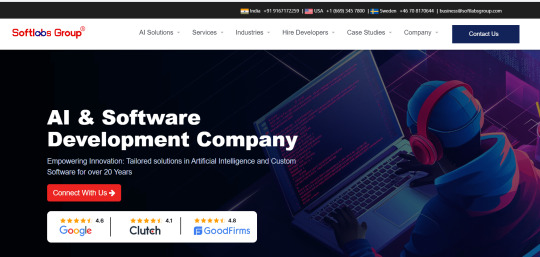
Founded: 2003
Headquarters: Mumbai, India
Global Presence: UK, US, Sweden
Company Overview: Founded in 2003, Softlabs Group is a premier software company headquartered in Mumbai, with a strong global footprint in the UK, US, and Sweden. With over two decades of industry experience, Softlabs Group is committed to delivering advanced and strategic IT solutions. They leverage cutting-edge technologies like AI, ML, and blockchain to drive digital transformation and innovation across various sectors. Their mission is to provide tailored and impactful solutions for their clients, ensuring success and growth.
Industries Served:
Banking
Fintech
Healthcare
Real Estate
Education
Manufacturing
Travel and Hospitality
Services Offered:
Custom Software Development
AI and ML Development
Blockchain Development
Mobile App Development
Web Development
Cloud Solutions
IT Consulting and Outsourcing
Ratings: ⭐ 4.5
Employee Base: 50-100
Accreditations:
ISO Certified
D-U-N-S Registered
Member of the Indian Chamber of Commerce
Contact Information: 📞 Phone: +91 9167172259 📧 Email: [email protected]
Address: D Wing, Kamala City, 6th Floor, Trade World, Senapati Bapat Marg, next to World One Towers, Lower Parel West, Mumbai, Maharashtra 400013
2. Binmile

Headquarters: Mumbai, India
Global Presence: USA, UK, India, Indonesia, UAE, Saudi Arabia
Company Overview: Binmile, founded in 2019, is an enterprise software development company with a significant global presence. They serve clients across the USA, UK, India, Indonesia, UAE, and Saudi Arabia. Binmile is renowned for its expertise in custom software development, application development, and AI and ML solutions. Their mission is to expedite digital transformation journeys for businesses by leveraging the latest technologies and ensuring exceptional service delivery.
Industries Served:
Healthcare
Retail
Manufacturing
Services Offered:
Custom Software Development
AI and ML Solutions
IoT App Development
AR/VR App Development
Cloud Solutions
Ratings: ⭐ 4.4
Employee Base: 250-999
Accreditations:
ISO Certified
Contact Information: 📞 Phone: +91-7669-410-017 📧 Email: [email protected]
Address: Plot No. D5, Road No. 20, Shree Krishna Nagar, Marol MIDC Industry Estate, Andheri East, Mumbai, Maharashtra 400069
3. Code B
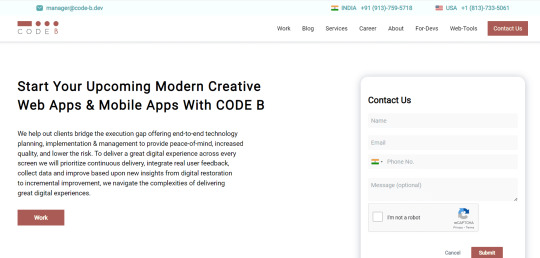
Employee Base: 50-100
Ratings: ⭐ 4.4
Accreditations: N/A
Company Overview: Code B is a technology company dedicated to delivering comprehensive software solutions tailored to the specific needs of businesses. They offer a diverse range of services, including custom software development, mobile and web application development, and IT consulting. Code B is focused on assisting businesses in achieving their digital transformation objectives through innovative technology and scalable solutions.
Industries Served:
Healthcare
Finance
Retail
Education
Services Offered:
Custom Software Development
Mobile and Web Application Development
IT Consulting
Contact Information: 📞 Phone: 091375 95718 📧 Email: N/A
Address: Bungalow No. 23, MHADA Colony, Mulund East, Mumbai, Maharashtra 400081
4. NeoSoft

Headquarters: Mumbai, India
Global Presence: Multiple countries
Company Overview: Neo Soft, established in 1996, is a global IT solutions provider headquartered in Mumbai with a footprint in several countries. With extensive experience in custom software development, mobile app development, web development, and cloud solutions, Neo Soft aims to boost business performance and foster innovation through advanced technology and client-centric solutions.
Industries Served:
Finance
Education
Travel & Hospitality
Services Offered:
Web Development
Cloud Solutions
DevOps
Ratings: ⭐ 4.2
Employee Base: 1000-5000
Accreditations:
ISO Certified
CMMI
Contact Information: 📞 Phone: +91-22-40500600 📧 Email: [email protected]
Address: 410, Anand Estate, Near A/C Market, Sane Guruji Marg, Mumbai 400011
5. Genpact

Workforce: Over 100,000 employees
Rating: 4.2 stars
Certifications: ISO Certified, CMMI Level 5
Email Contact: [email protected]
Phone Contact: +91-124-441-4000
Office Location:
Genpact India
7th Floor, Tower 2, Raiaskaran Tech Park,
Andheri Kurla Road, Sakinaka, Andheri East,
Mumbai, Maharashtra 400072
Genpact is a leading global firm specializing in professional services and digital transformation powered by data and cutting-edge technology. They provide a wide array of services, including analytics, risk management, financial services, supply chain management, and customer service.
Genpact partners with a variety of industries such as banking, capital markets, insurance, life sciences, healthcare, consumer goods, and manufacturing. Their expertise enables clients to enhance growth and improve operational efficiency.
Industries Served: Life Sciences, Healthcare, Consumer Goods, Manufacturing
Core Services: Digital Transformation, Analytics, Risk Management
6. Techasoft
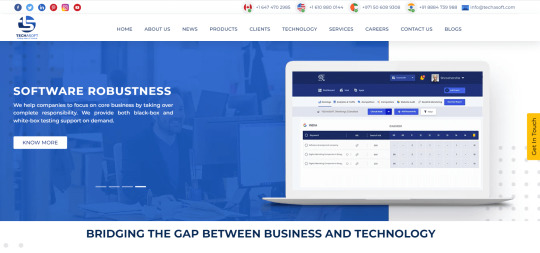
Employee Base: 50-200
Ratings: ⭐ 4.1
Accreditations:
ISO Certified
Company Overview: Techasoft is a premier IT services and consulting company headquartered in Bangalore, with an office in Thane, Maharashtra. The company excels in software development, web development, mobile app development, and digital marketing. Techasoft is dedicated to helping businesses maintain a competitive edge in the digital era by delivering high-quality, customized IT solutions tailored to specific industry requirements.
Industries Served:
Healthcare
Education
Real Estate
Services Offered:
Software Development
Web Development
Mobile App Development
Contact Information: 📞 Phone: +91-80-41228268 📧 Email: [email protected]
Address: Jagdish Industrial Estate, Acharya Atre Marg, Tulsi Dham, Vedant Complex, Vartak Nagar, Thane West, Thane, Gala No: 110, Thane, Maharashtra 400606
7. Brainvire
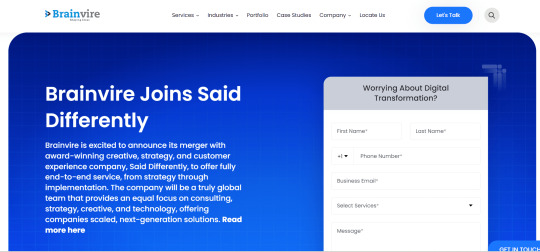
Employee Base: 500-1000
Ratings: ⭐ 4.0
Accreditations:
ISO Certified
Company Overview: Brainvire is a global IT consulting and digital transformation company with a robust presence in the USA, UAE, and India. They excel in providing innovative solutions in IT consulting, digital transformation, cloud services, data analytics, and cybersecurity. Brainvire’s vision is to empower businesses with technology-driven solutions that enhance operational efficiency and foster growth.
Industries Served:
E-commerce
Manufacturing
Telecommunication
Services Offered:
Mobile App Development
Web Development
Contact Information: 📞 Phone: +91-22-67425300 📧 Email: [email protected]
Address: Lotus Corporate Park, E, E 701, Western Express Hwy, Geetanjali Railway Colony, Laxmi Nagar, Goregaon, Mumbai, Maharashtra 400063
8. Devs Data Tech
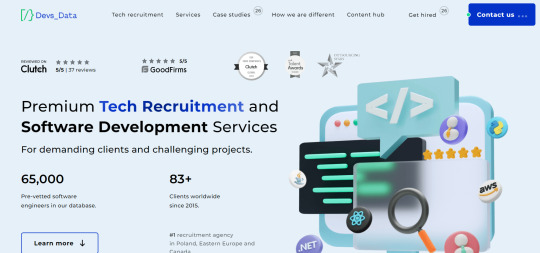
Employee Base: 50-100
Ratings: ⭐ 4.1
Accreditations:
ISO Certified
D-U-N-S Registered
Member of the Indian Chamber of Commerce
Company Overview: Devs Data Tech is dedicated to delivering advanced software development, AI and machine learning, data engineering, and cloud solutions. The company focuses on providing high-quality tech solutions tailored to the specific needs of its clients. Serving a diverse range of industries, Devs Data Tech leverages innovative technology and efficient service delivery to meet and exceed client expectations.
Industries Served:
Retail
Logistics
Manufacturing
Services Offered:
Software Development
AI and ML Solutions
Data Engineering
Contact Information: 📞 Phone: 07666483505 📧 Email: [email protected]
Address: Podar House, Office No. 2, Netaji Subhash Chandra Rd, Mumbai, 400020, India
Here are some well-known tech giants with a significant presence in Mumbai, India's financial capital. While you may already be familiar with these industry leaders, the purpose of this blog is to shed light on the emerging companies that are driving groundbreaking changes in the tech landscape.
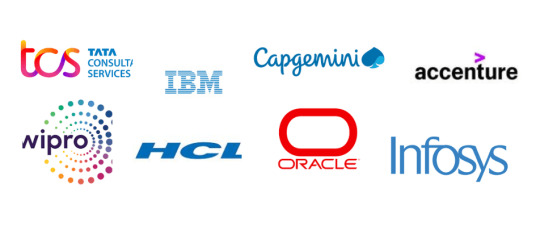
Benefits of Partnering with Software Companies in Mumbai
Partnering with software companies in Mumbai comes with numerous advantages, making it a strategic choice for many businesses. Here are the key benefits:
1. Access to Skilled Talent Pool According to the India Skills Report 2024, Mumbai boasts a large pool of highly skilled software developers and engineers. Notably, 48.27% of IT professionals in Mumbai scored above 60% on employability tests, reflecting the city’s strong talent base.
2. Cost-Effectiveness Partnering with software companies in Mumbai can result in substantial cost savings. For instance, the average annual salary of a software engineer in the US is around $91,900, whereas in India, it's only about $4,796. Additionally, other operational expenses such as office space rent and electricity are significantly lower in Mumbai.
3. Cultural Alignment for Global Clients Mumbai has a large English-speaking population, with over 125 million English speakers. In 2021, the city ranked 6th in Asia on the EF English Proficiency Index, ensuring efficient communication and collaboration between clients and outsourcing partners.
4. Government Support and Incentives The Indian government provides various incentives and support for the IT industry, including tax benefits, subsidies, and infrastructure development. These measures create a favorable environment for software companies in Mumbai.
Partnering with software companies in Mumbai offers a unique blend of skilled talent, cost-effectiveness, cultural alignment, and government support, making it an ideal destination for software development outsourcing.
Conclusion
Mumbai has solidified its position as a powerhouse in the software industry, creating a vibrant environment for both technology startups and established firms. Leading the charge is Softlabs Group, renowned for its innovative solutions and over two decades of experience. The city's tech landscape is characterized by a blend of expertise, versatility, and forward-thinking approaches.
Softlabs Group exemplifies this with its wide range of AI applications, including AI-powered chatbots for customer support and predictive maintenance systems for manufacturing. With their comprehensive capabilities and commitment to excellence, they are well-equipped to meet diverse client needs.
Reach out to Softlabs Group with your requirements today and kickstart your project with one of Mumbai's finest tech companies!
0 notes
Text
How to Unlock Business Potential with Dedicated Developers
Introduction
In today's rapidly evolving business landscape, leveraging technology is not just an option but a necessity for sustained growth and competitiveness. As companies strive to innovate and improve their operations, the role of skilled professionals becomes increasingly crucial. Among these professionals, dedicated developers stand out as pivotal contributors to technological advancement and business success.

Dedicated developers are specialized professionals who work exclusively for a single client or project, ensuring focused and high-quality output. Their relevance in today’s business world cannot be overstated. They bring a wealth of expertise, allowing businesses to accelerate development timelines, reduce costs, and enhance the overall quality of their digital solutions.
This blog post will delve into the key benefits of hiring dedicated developers, highlighting how they can drive business growth through technological excellence. We will explore how these professionals provide specialized skills, foster innovation, and offer scalability, ultimately contributing to a company's strategic objectives.
Understanding Dedicated Developers
Definition of Dedicated Developers
Dedicated developers are specialized professionals who work exclusively on a specific project or for a particular client. Unlike general developers who may juggle multiple projects or clients, dedicated developers focus all their efforts on a single assignment, ensuring consistent and high-quality results. They are often part of dedicated development teams provided by third-party service providers, and their primary objective is to meet the client's specific needs and goals.
Difference Between Dedicated Developers and Other Types of Developers
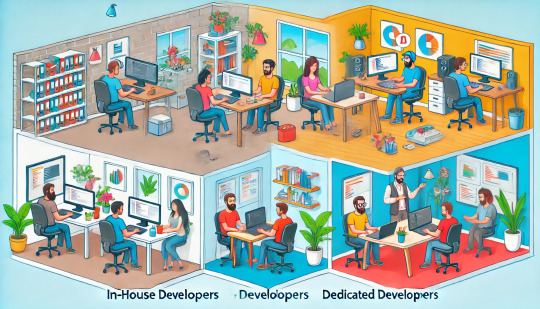
In-house Developers:
Commitment: In-house developers are permanent employees of a company, working on various projects as assigned by their employer.
Flexibility: They have a broader scope of responsibilities and may be involved in multiple aspects of the business.
Cost: Hiring in-house developers involves significant overhead costs, including salaries, benefits, and other employee-related expenses.
Freelancers:
Commitment: Freelancers work on a project-by-project basis, often juggling multiple clients and assignments.
Flexibility: They offer flexibility in terms of availability and may provide expertise in niche areas.
Cost: Freelancers can be more cost-effective for short-term projects but may lack the long-term commitment and consistency required for ongoing projects.
Dedicated Developers:
Commitment: Dedicated developers work exclusively for a single client or project, providing focused and consistent efforts.
Flexibility: They offer a balance between the commitment of in-house developers and the flexibility of freelancers, often being part of an external dedicated team.
Cost: While hiring dedicated developers can be an investment, it often results in cost savings through increased efficiency and reduced time-to-market.
Common Misconceptions About Dedicated Developers
High Cost:
Reality: While it may seem that hiring dedicated developers is expensive, it often proves cost-effective in the long run due to increased productivity, reduced development time, and higher quality outputs.
Lack of Control:
Reality: Many fear losing control over their projects when working with dedicated developers. However, with clear communication, regular updates, and proper management tools, businesses can maintain excellent control and oversight.
Integration Challenges:
Reality: Some believe that dedicated developers may struggle to integrate with existing teams. In practice, these professionals are skilled at collaborating with in-house teams, understanding business goals, and seamlessly integrating their efforts.
Key Benefits of Hiring Dedicated Developers
Cost Efficiency
Hiring dedicated developers can be significantly more cost-effective than maintaining an in-house team. In-house teams come with substantial overhead costs, including salaries, benefits, office space, and training expenses. In contrast, dedicated developers, often provided by third-party vendors, come as a comprehensive package, eliminating many of these overheads.
Cost Comparison with Other Hiring Models:
In-house Teams: High costs due to salaries, benefits, office infrastructure, and long-term commitments.
Freelancers: Lower costs for short-term projects but potential issues with consistency and reliability.
Dedicated Developers: Balanced cost model with focused expertise and long-term reliability, often resulting in overall cost savings through improved efficiency and productivity.
Access to Specialized Skills
Dedicated developers bring a wealth of specialized technical skills that may not be available within an in-house team. Their expertise spans various technologies and frameworks, enabling businesses to leverage the latest advancements without the need for extensive training.
Examples of Specialized Skills:
Proficiency in advanced programming languages (e.g., Python, Java, C#)
Expertise in modern frameworks and libraries (e.g., React, Angular, Django)
Experience with cloud services (e.g., AWS, Azure, Google Cloud)
Specialized knowledge in areas like AI, machine learning, and data analytics
Flexibility and Scalability
One of the standout benefits of dedicated developers is the flexibility they offer in scaling projects. Whether a business needs to ramp up development efforts quickly or scale down after project completion, dedicated developers provide the agility required to adapt to changing needs.
Case Study: A mid-sized e-commerce company needed to rapidly scale its platform to handle increased traffic during the holiday season. By hiring a team of dedicated developers, they quickly expanded their development capacity, improved website performance, and managed higher user loads without permanent overhead costs.
Focus on Core Business Activities
Outsourcing development tasks to dedicated developers allows businesses to concentrate on their core competencies. By delegating technical work to experts, companies can focus on strategic planning, marketing, customer engagement, and other critical areas that drive growth.
Example: A healthcare start-up outsourced its app development to a team of dedicated developers. This allowed the start-up's internal team to focus on patient care and expanding their service offerings, resulting in better overall business performance and growth.
Enhanced Productivity and Quality
Dedicated developers are committed to delivering high-quality work within specified timelines. Their focused approach and specialized skills often lead to enhanced productivity and superior quality of deliverables, ensuring projects are completed efficiently and to a high standard.
Example: A fintech company partnered with dedicated developers to create a new mobile banking app. The dedicated team's expertise and focused efforts led to a smooth and timely launch, with the app receiving high praise for its functionality and user experience, ultimately boosting the company's reputation and customer satisfaction.
How to Hire Dedicated Developers
Identifying Business Needs
Before hiring dedicated developers, it’s crucial to clearly understand your business requirements and technical needs. Proper assessment ensures that you choose the right developers who can meet your project goals efficiently.
Tips on Assessing Business Requirements and Technical Needs:
Define Project Goals: Clearly outline the objectives and desired outcomes of your project.
Identify Required Skills: List the technical skills and expertise needed to achieve your project goals.
Determine Budget and Timeline: Set a realistic budget and project timeline to guide your hiring process.
Checklist for Determining the Scope of the Project:
Project objectives and key deliverables
Technical requirements and necessary skills
Budget constraints
Timeline and milestones
Potential challenges and risks
Choosing the Right Hiring Model
Selecting the appropriate hiring model is essential to align with your business needs and project scope. Different models offer various levels of commitment and flexibility.
Overview of Different Hiring Models:
Full-time: Developers work exclusively on your project, providing dedicated support throughout the development process.
Part-time: Developers split their time between your project and other commitments, offering flexibility for smaller or less time-sensitive tasks.
Project-based: Developers are hired for the duration of a specific project, with a clear start and end date.
Tips for Selecting the Best Model Based on Business Needs:
Full-time: Ideal for long-term projects requiring continuous development and support.
Part-time: Suitable for smaller projects or when you need additional support without full-time commitment.
Project-based: Best for short-term projects with well-defined goals and timelines.
Evaluating Potential Developers
Evaluating developers thoroughly ensures you hire the right talent for your project. Focus on their skills, experience, and fit with your company culture.
Criteria for Evaluating Developers:
Technical Skills: Assess their proficiency in required programming languages and frameworks.
Experience: Look for relevant experience in similar projects or industries.
Portfolio: Review their previous work to gauge quality and expertise.
Soft Skills: Consider their communication, problem-solving, and teamwork abilities.
Tips for Conducting Effective Interviews and Technical Assessments:
Prepare Relevant Questions: Ask about their experience, approach to problem-solving, and familiarity with your required technologies.
Technical Tests: Use coding challenges or technical assessments to evaluate their practical skills.
Behavioral Interviews: Assess their cultural fit and soft skills through situational and behavioral questions.
Onboarding and Integration
Effective onboarding and integration are key to ensuring dedicated developers can contribute effectively from the start. Proper onboarding helps them understand your business processes, tools, and culture.
Best Practices for Onboarding Dedicated Developers:
Welcome and Orientation: Provide a warm welcome and an overview of your company, team, and project.
Resource Access: Ensure they have access to necessary tools, software, and documentation.
Training and Support: Offer training on your processes and systems, and provide ongoing support as needed.
Strategies for Integrating Developers into the Existing Team and Processes:
Clear Communication: Establish regular communication channels and update meetings.
Collaborative Tools: Use project management and collaboration tools to streamline workflows and communication.
Team Building: Encourage team-building activities to foster a sense of belonging and collaboration.
Feedback Mechanism: Implement a feedback system to address any issues promptly and improve integration.
Maximizing the Potential of Dedicated Developers
Effective Communication and Collaboration
Clear communication and collaboration are essential for maximizing the potential of dedicated developers. Establishing robust communication channels and utilizing collaboration tools can significantly enhance productivity and project outcomes.
Importance of Clear Communication and Collaboration Tools:
Ensures Alignment: Keeps all team members on the same page regarding project goals, tasks, and progress.
Facilitates Problem-solving: Enables quick resolution of issues through real-time communication.
Boosts Morale: Promotes a sense of belonging and teamwork, even in remote settings.
Tips for Maintaining Effective Communication with Remote Developers:
Regular Check-ins: Schedule daily or weekly meetings to discuss progress, address challenges, and plan next steps.
Use Collaboration Tools: Leverage tools like Slack, Microsoft Teams, or Zoom for real-time communication and project management platforms like Jira or Trello for task tracking.
Clear Documentation: Maintain comprehensive documentation of project requirements, guidelines, and updates to ensure everyone has access to essential information.
Setting Clear Goals and Expectations
Setting clear goals and expectations is crucial for guiding dedicated developers and ensuring that project milestones are met. Transparent communication about objectives helps developers understand their roles and responsibilities.
Importance of Setting Clear Project Goals and Expectations:
Focuses Efforts: Provides direction and clarity, helping developers priorities tasks and work efficiently.
Reduces Misunderstandings: Minimizes confusion and ensures everyone is working towards the same objectives.
Enhances Accountability: Establishes measurable targets and timelines, promoting responsibility and ownership.
Examples of How to Communicate Goals Effectively:
SMART Goals: Define Specific, Measurable, Achievable, Relevant, and Time-bound goals to provide clear direction.
Project Roadmaps: Create detailed project roadmaps outlining key milestones, deadlines, and deliverables.
Regular Updates: Share progress updates and adjust goals as needed to keep the project on track.
Regular Monitoring and Feedback
Regular monitoring and feedback are vital for maintaining the quality of work and ensuring continuous improvement. Constructive feedback helps developers stay aligned with project goals and enhances their performance.
Strategies for Monitoring Progress and Providing Constructive Feedback:

Performance Metrics: Use key performance indicators (KPIs) to measure progress and productivity.
Feedback Sessions: Conduct regular one-on-one meetings to discuss performance, address concerns, and provide guidance.
360-Degree Feedback: Implement a 360-degree feedback system where peers, managers, and clients provide input on performance.
Tools and Techniques for Tracking Developer Performance:
Project Management Tools: Utilize tools like Asana, Jira, or Monday.com to track tasks, deadlines, and progress.
Time Tracking Software: Use time tracking tools like Toggl or Harvest to monitor work hours and productivity.
Progress Reports: Request regular progress reports summarizing completed tasks, ongoing work, and upcoming milestones.
Conclusion
In summary, leveraging dedicated developers can significantly contribute to business growth and technological advancement. Here's a quick recap of the key points discussed in this post:
Understanding Dedicated Developers: We defined dedicated developers, highlighted the differences between them and other types of developers, and debunked common misconceptions.
Key Benefits of Hiring Dedicated Developers: We explored cost efficiency, access to specialized skills, flexibility and scalability, the ability to focus on core business activities, and enhanced productivity and quality.
How to Hire Dedicated Developers: We provided tips on identifying business needs, choosing the right hiring model, evaluating potential developers, and best practices for onboarding and integration.
Maximizing the Potential of Dedicated Developers: We emphasized the importance of effective communication and collaboration, setting clear goals and expectations, and regular monitoring and feedback.
Considering the numerous advantages they offer, dedicated developers are a viable and strategic option for businesses aiming to enhance their technological capabilities and drive growth. Their specialized skills, commitment, and flexibility make them invaluable assets for any project.
Call-to-Action: If you're ready to take your business to the next level, explore the potential of hiring dedicated developers. Their expertise and focused efforts can help you achieve your project goals efficiently and effectively. Start your journey towards business growth and technological excellence by reaching out to a reliable service provider today.
0 notes
Text
How to Manage and Motivate Your Development Team

Introduction
Effective management and motivation are crucial in software development, where success relies on team productivity and engagement. This article explores strategies to manage and motivate development teams, focusing on fostering collaboration, innovation, and continuous improvement.
Understanding Your Team's Needs
Recognize Individual Strengths and Weaknesses Identify each team member's unique skills to assign tasks that align with their strengths. Provide targeted training to address weaknesses and promote continuous skill development.
Cater to Developer Preferences Align tasks with developers' interests, whether they prefer front-end or back-end work. Accommodate preferred communication styles, whether through regular meetings, team discussions, or digital tools, to enhance job satisfaction and productivity.
Foster a Supportive Environment Encourage open communication where developers feel comfortable sharing ideas and concerns. Regularly check in with your team to address issues promptly and show genuine interest in their well-being and professional growth to build trust and loyalty.
Setting Clear Goals and Expectations
Define Clear Goals Set specific, measurable, achievable, relevant, and time-bound (SMART) goals to provide direction, enhance focus, and measure progress. Involve your team in goal-setting to ensure they are realistic and attainable.
Communicate Team Expectations Ensure every team member understands their role, responsibilities, and performance standards. Clear communication reduces confusion, enhances efficiency, and fosters a culture of accountability where team members take ownership of their tasks.
Establish Project Milestones Break down large projects into manageable chunks with regular milestones. This helps track progress, maintain motivation, and ensure the project stays on course, aligning team efforts with overall objectives and timelines.
Providing Necessary Tools and Resources
Invest in Development Tools Equip your team with essential tools like IDEs, version control systems, and collaboration platforms to streamline workflows. Tools such as Visual Studio Code, Git, and Slack facilitate coding, debugging, testing, and communication among team members.
Provide Essential Resources Offer access to learning platforms like Udemy and Coursera, comprehensive documentation, and up-to-date hardware to support continuous improvement and efficient work processes. High-performance computers and ergonomic workstations can significantly boost productivity and comfort.
Encouraging Open Communication
Importance of Open Communication Foster enhanced collaboration, transparency, and problem-solving by maintaining open communication channels within the team. Open communication ensures that everyone is aligned, informed, and engaged.
Establishing a Feedback Culture Regular feedback sessions, peer feedback, and positive reinforcement help in continuous improvement and professional growth. Schedule regular one-on-one meetings and performance reviews to provide timely and specific feedback.
Role of Team Meetings Conduct regular team meetings, such as daily stand-ups and weekly check-ins, to keep everyone informed, engaged, and aligned with project goals. Encourage active participation and address key issues to ensure effective collaboration.
Recognizing and Rewarding Achievements
Benefits of Recognizing Developers Acknowledging achievements boosts engagement, morale, and performance, creating a positive work environment. Recognition helps developers feel more connected to their work and the organization.
Establishing an Effective Reward System Implement a mix of monetary and non-monetary rewards, such as bonuses, public acknowledgment, awards, and career advancement opportunities. Personalized rewards like additional time off or professional development can be highly motivating.
Conclusion
Effective management and motivation involve understanding team needs, setting clear goals, providing necessary tools, encouraging open communication, and recognizing achievements. Implementing these strategies enhances team performance, job satisfaction, and overall project success.
Key Takeaways:
Recognize individual strengths and preferences.
Set clear, achievable goals.
Provide essential tools and resources.
Encourage open communication and feedback.
Implement a robust recognition and reward system.
Investing in your developers' well-being and growth leads to a motivated and high-performing team, ultimately driving project success and organizational growth.
0 notes
Text
Future of AI in India: Astonishing Predictions Revealed!

AI is no longer a mere buzzword; it's a revolutionary force reshaping our daily lives. From the moment we wake up to the customized recommendations on our devices, AI operates seamlessly in the background, enhancing efficiency and convenience. It's the quiet conductor of a transformative symphony.
AI solutions are becoming increasingly immersive, influencing sectors such as healthcare, agriculture, and transportation. For India, a country with a vast population and ambitious development objectives, AI’s potential is particularly profound.
This blog delves into the future of AI in India. We’ll examine how AI can propel India's growth and development, assess the current AI landscape, and discuss the thrilling possibilities on the horizon. Whether you’re a student curious about future careers, a professional looking to upskill, or an entrepreneur seeking innovative solutions for your business, this blog provides valuable insights and sparks the imagination for the future.
Understanding the Powerhouse: Artificial Intelligence
Artificial Intelligence, or AI, involves programming machines to emulate human intelligence, enabling them to think and learn similarly to humans. These advanced systems can execute tasks like speech recognition, decision-making, and problem-solving. Essentially, AI empowers computers and machines to undertake activities traditionally requiring human intelligence.
For a clearer understanding, here’s a visual representation showcasing various types of AI and their expected timelines for development.

Different Types of AI
AI can be categorized into three types based on their capabilities:
Artificial Narrow Intelligence (ANI): Also known as Weak AI, ANI is designed to perform specific tasks such as facial recognition or conducting internet searches. It operates within a limited scope and cannot execute tasks beyond its predefined functions. Even OpenAI's ChatGPT and GPT-4 models fall under this category.
Artificial General Intelligence (AGI): Referred to as Strong AI, AGI can comprehend, learn, and apply knowledge across a diverse range of tasks, mirroring human intelligence. It can think, understand, and perform tasks independently. Leading AI companies in India and worldwide are currently developing AGI, with projections suggesting it will be available within the next five years.
Artificial Superintelligence (ASI): ASI is a theoretical form of AI that would surpass human intelligence in all aspects, including creativity, problem-solving, and emotional understanding. While ASI has not yet been achieved, it is anticipated to emerge in a decade or more.
History of AI Development in India
Let's embark on a brief journey through the evolution of AI in India. The seeds of AI were planted in the 1960s with foundational concepts, gradually advancing over the decades. Significant progress was made in the 2000s, propelled by government initiatives and substantial investments from technology companies.

Where Does India Stand in the AI Race?
According to the Stanford AI Index Report, the United States is the foremost consumer of artificial intelligence (AI) technology, having invested $328.5 billion (about $1,000 per person in the US) over the last five years, including $67.9 billion (about $210 per person in the US) in 2023 alone. This substantial funding underscores the U.S.'s robust commitment to advancing AI technology across diverse sectors.
China is the second-largest investor, having spent $132.7 billion on AI from 2019 to 2023. However, its investment has seen a recent decline, amounting to $15.1 billion in 2023. The United Kingdom ranks third with an investment of $25.5 billion over the same period.
India holds the fourth position globally, with a notable investment of $16.1 billion in AI over the past five years. This achievement places India ahead of Germany and emphasizes its rising significance in the global AI landscape. India's investments are largely driven by initiatives such as the forthcoming India AI program, designed to support local startups and stimulate innovation in AI.
In terms of AI innovation, the founder of OLA in India introduced a chatbot called Krutrim AI. This initiative aims to position India within the competitive realm of large language models (LLMs). Although Krutrim AI has not yet reached the sophistication of models like GPT-4 or Claude, it marks a crucial step towards fostering a vibrant AI innovation ecosystem in India. This endeavor highlights India's potential to swiftly develop advanced AI technologies.

How is AI Transforming Different Industries in India?
Let's explore the remarkable impact of AI across various sectors. This information is invaluable for job seekers or aspiring entrepreneurs eager to understand the opportunities within India’s AI landscape.
1. AI in Agriculture
Market Value: Expected to reach $2.05 billion in 2024.
Future Growth: Projected to grow at an annual rate of 25.1%, reaching $7.85 billion by 2030.
Key Drivers: Increased use of IoT in farming and rising demand for higher crop yields.
AI Initiatives: The AI for Agriculture Innovation (AI4AI) initiative, launched in 2020, brought together public and private stakeholders to pilot AI technologies in Telangana, enhancing crop management and productivity (Access Partnership Report).
2. AI in Healthcare
Market Size: Valued at $10 billion in 2023.
Future Growth: Expected to grow to $35 billion by 2030, with a 30% annual growth rate.
Key Drivers: The need for improved efficiency and better decision-making.
Source: Inkwood Research.
3. AI in Manufacturing
Market Size: Projected to reach INR 12.59 billion by 2028.
Future Growth: Growing at a 20.2% annual rate from 2023 to 2028.
Key Drivers: Changing customer preferences, new distribution models, and supply chain disruptions.
Generative AI Impact: Can potentially unlock USD 621 billion of productive capacity in India, with manufacturing being a significant contributor (41%) (Access Partnership Report).
4. AI in Transportation and Logistics
Market Size: Expected to reach INR 6.71 billion by 2028.
Future Growth: Growing at 18.5% annually from 2023 to 2028.
Key Drivers: The need for improved efficiency and better decision-making.
Source: Market US.
5. AI in Finance
Market Value: Expected to reach $8 billion by 2025.
Future Growth: Growing at a CAGR of over 40% from 2020 to 2025.
Key Drivers: Advancements in data collection technology among banks and financial institutions, increased bank investments in AI, and rising consumer demand for personalized financial services.
Source: International Trade Administration.
6. AI in Telecommunication
Market Value: Part of the Asia-Pacific region.
Future Growth: Accelerated growth due to 5G infrastructure investments and a large, growing population.
Key Drivers: Enhancing customer experience, fraud and risk management.
Source: Markets and Markets.
7. AI in Energy
Market Value: Projected to grow at a CAGR of 28.8% from 2024 to 2029.
Future Growth: Strong growth in the adoption of AI technologies within the Indian renewable energy industry.
Key Drivers: Government initiatives, operational efficiency, sustainability goals.
Source: Global Market Estimates.
8. AI in E-commerce
Market Value: Expected to reach $112.93 billion in 2024 and $299.01 billion by 2029.
Future Growth: Growing at a CAGR of 21.5%.
Key Drivers: Rising internet and smartphone penetration, increasing adoption in tier 2/3 cities, and the COVID-19 pandemic accelerating the shift to online shopping.
Source: Mordor Intelligence.
In essence, AI is revolutionizing various industries in India, enhancing efficiency, reducing costs, and enabling better decision-making.
Adoption of Artificial Intelligence in India
According to a recent report by the Times of India, 9 out of 10 internet users in India, approximately 724 million people, are already integrating AI into their daily lives. This includes using AI features such as image filters, personalized recommendations, and smart devices.
Professions Most Frequently Using AI in India
Marketers and Digital Professionals
Usage: Marketers in India are leveraging AI tools like chatbots and predictive analytics for content creation, campaign optimization, and customer segmentation.
Statistics: 75.7% of digital marketers use AI tools, with 49.5% using them multiple times per week or more. Additionally, 85.1% of AI users in India utilize it for creating blog content and writing articles.
Business Professionals
Professions: Management consultants, business analysts, financial managers, accountants, and purchasing managers.
Benefits: AI assists these professionals by providing data-driven insights, optimizing processes, and enabling more informed decision-making.
Educators
Statistics: 62% of educators in India employ Generative AI (GenAI) tools in teaching and preparation, enhancing the delivery and engagement of educational content.
Usage: AI is used to generate lesson plans, provide feedback on student writing, and create personalized learning experiences.
Initiative: In September 2022, NITI Aayog, the Central Board of Secondary Education, and Intel India launched the Integrating AI and Tinkering with Pedagogy (AIoT) program in fifty schools to embed AI into subject pedagogies, improving personalized learning and educational outcomes.
Legal Professionals
Professions: Solicitors and legal professionals.
Usage: AI language models are utilized for drafting legal documents, conducting research, and providing insights on case law, making the legal services industry one of the most affected by AI.
Customer Service
Statistics: 80% of businesses in India have integrated chatbots into their customer experience strategies.
Motivation: 40% of Indian businesses cite customer experience as their primary motivator for adopting AI.
Impact: AI-powered chatbots are significantly enhancing customer service operations (Times Now report).
Industry-wise Adoption of AI
The adoption of AI in India is transforming various sectors, driven by innovative applications, supportive government initiatives, and contributions from key industry players. Here are the top industries leading the AI revolution:
AI in Healthcare
Market Growth: By 2025, spending on AI in the healthcare sector in India is expected to reach $11.78 billion.
Job Creation: AI is projected to create nearly three million jobs by 2028, significantly altering the employment landscape in healthcare.
Innovative Application: Aarya.ai, a notable startup, employs algorithms to analyze medical images, speeding up and improving the accuracy of disease diagnosis.
AI in Manufacturing
Growth Rate: AI adoption in the manufacturing sector increased by 20% from 2020 to 2023.
Primary Uses: Enhancing manufacturing operations, managing supply chain logistics, and improving IT and cybersecurity.
Success Story: FP McCain, a UK-based manufacturing company, implemented AI solutions from Softlabs Group for:
Detecting proper use of Personal Protective Equipment (PPE)
Monitoring for overloads
Ensuring Air Quality and Building Safety (AQBS)
Impact: This AI integration led to:
30% reduction in workplace accidents
25% decrease in shipment errors
20% improvement in logistics efficiency
AI's integration across these sectors exemplifies its potential to drive efficiency, enhance safety, and create new job opportunities. Explore more case studies to see AI's transformative impact.
AI in Government Initiatives
India's government is making significant strides in AI with ambitious plans. They have launched the IndiaAI mission with a budget of over Rs. 10,000 crore, aiming to:
Spark AI Innovation: Foster the development of innovative AI solutions.
Accessible Computing: Ensure that computing resources are available to everyone.
Data Quality Improvement: Enhance the quality of data for AI applications.
Homegrown AI Technologies: Develop indigenous AI technologies to reduce dependence on foreign solutions.
Additionally, the national program for AI was established in 2018, preceding the release of GPT-4, to craft a national strategy for responsible AI adoption, ensuring inclusive AI-enabled economic growth. In the 2023 budget, the government announced the creation of three Centers of Excellence in AI as part of the "Make AI for India" and "Make AI Work for India" initiatives.
These initiatives underscore the government's commitment to building a robust AI ecosystem in the country.

Several top companies are spearheading the AI revolution in India, offering solutions that address the most common business needs:
Arya-AI
Focus: AI-driven business solutions for BFSI clients.
Limitation: While they provide standardized offerings, they often lack the customization needed for other industries.
Haptik-AI
Specialty: Known for its chatbots.
Limitation: Solutions can sometimes feel generic and less tailored to specific industry needs.
Yellow-AI
Focus: AI solutions primarily for customer service, including Language Models and chatbots.
Limitation: Lacks robust solutions for hardcore industries such as Real Estate or Manufacturing.
Softlabs Group
Innovation Leader: At the forefront of AI innovation, delivering cutting-edge solutions tailored to diverse business needs.
Solutions: From developing intelligent chatbots to implementing advanced recommendation systems, Softlabs Group leverages AI for transformative results.
Reputation: Recognized as one of the top AI companies in Mumbai.
Recent Developments: Check out their recently developed research-backed AI solutions for more insights into their innovative approaches.
These companies are pivotal in driving AI adoption across various sectors in India, each contributing uniquely to the growing AI ecosystem.
What are the Barriers to AI Adoption in India?
Here’s a breakdown of the top barriers to implementing artificial intelligence in India and solutions to overcome these challenges:
1. Complex Regulations and Standards
Barrier: Standardization of AI presents a major challenge, making it difficult for companies to integrate AI solutions.
Statistic: According to an EY survey, about 63% of Indian businesses identified compliance with global data protection and privacy laws as the biggest challenge to AI adoption.
Solution: Developing clear, harmonized regulations and providing guidance on compliance can help ease integration issues.
2. Lack of Incentives for Businesses
Barrier: Implementing AI can be costly, involving expenses for data, hardware, software, and skilled employees.
Statistic: Despite high costs, 74% of large companies in India have accelerated their AI investments in the past 24 months, focusing on research and development (67%) and workforce reskilling (55%).
Solution: Offering financial incentives, subsidies, or tax breaks can encourage more businesses to adopt AI.
3. Centralization Issues
Barrier: AI governance is often centralized, with control in the hands of the government and large corporations, limiting innovation and access for smaller businesses.
Solution: Decentralizing AI governance and encouraging open-source projects can foster innovation and make AI more accessible.
4. Skills Gap
Barrier: The lack of internal technical skills is a significant hurdle.
Statistic: According to Infosys, this skills gap is the top challenge hindering businesses from utilizing emerging technologies effectively. Only 38% of households in India are digitally literate.
Solution: Initiatives like the Pradhan Mantri Gramin Digital Saksharta Abhiyan (PMGDISHA) aim to improve digital literacy in rural areas. Additionally, the Ministry of Electronics and IT (MeitY) plans to create one million skilled AI professionals by 2025 to bridge this gap.
5. Ethical and Legal Concerns
Barrier: Ethical concerns such as data privacy and bias are significant obstacles.
Statistic: According to IBM, about 26% of companies cite ethical concerns as a challenge.
Solution: Establishing robust data privacy laws and security measures, along with strict compliance, can help mitigate these concerns and build customer trust.
6. Economic Factors
Barrier: High costs deter many businesses from adopting AI.
Solution: Starting with small AI projects and scaling up gradually can help manage expenses. Partnering with AI vendors can also reduce costs.
By addressing these challenges with targeted, practical steps, India can enhance its AI capabilities and position itself as a leader in the global AI industry.
What Does India Need to Reach the Top in the AI Race?
To become a global leader in artificial intelligence, India must address key challenges and leverage its unique strengths effectively. Here are the critical steps:
1. Investment in AI Research and Development
Increase Funding: Enhance funding from both government and private sectors to boost AI research and innovation.
Encourage Collaboration: Foster partnerships between universities, industries, and the government to develop new AI technologies.
Example: The India AI program supports local startups and promotes AI innovation.
2. Robust Infrastructure
High-Performance Computing: Develop high-performance computing systems and large GPU clusters for AI projects.
Energy-Efficient Data Centers: Establish data centers that are energy-efficient for AI data storage and processing.
Example: NVIDIA’s AI Technology Centre at IIT Hyderabad supports AI research.
Update: On June 28th, 2024, Ola founder Bhavish Aggarwal announced the launch of a decentralized GPU service aimed at boosting AI computing capabilities across various sectors in India. This initiative will provide affordable access to high-performance GPUs, enabling individuals and businesses to rent them hourly for AI model training.


3. Ethical and Regulatory Framework
Create Ethical Rules: Establish guidelines to ensure AI is used ethically, transparently, and responsibly.
Implement Regulations: Develop regulations that protect privacy and security while fostering innovation.
Example: Japan’s balanced approach to AI innovation and risk management.
4. Public-Private Partnerships
Encourage Collaborations: Foster partnerships between the government, private companies, and startups to support AI projects.
Example: Collaborations between Indian companies like Reliance and Tata with global leaders like NVIDIA and Google.
5. Data Accessibility and Quality
Promote Data Sharing: Encourage the sharing of high-quality and diverse datasets for better AI model training.
Ensure Data Protection: Maintain strong data protection measures to ensure user trust and comply with privacy laws.
Example: The IndiaAI Datasets Platform aims to streamline access to high-quality non-personal datasets for AI innovation.
6. Innovation Hubs and Startups
Support Startups: Provide funding, mentorship, and infrastructure support to AI startups.
Establish Innovation Hubs: Create AI innovation hubs and centers of excellence to nurture new ideas and research.
Example: IndiaAI Startup Financing accelerates deep-tech AI startups by streamlining access to funding for innovative AI projects.
7. Retaining Talent in India
Utilize Diverse Population: Leverage India's diverse population to collect varied data for robust AI models.
Encourage Specialization: Promote AI specialization through initiatives like AI For All by Intel.
Create Job Opportunities: Develop AI-related job opportunities to prevent brain drain and retain skilled talent.
Example: IndiaAI Future Skills focuses on expanding AI education at all academic levels and establishing Data and AI Labs in Tier 2 and 3 cities.
By addressing these needs, India can become a global leader in AI, driving economic growth, job creation, and technological progress.
What Global Leaders Say About the Future of AI in India?
Let's explore insights from prominent personalities in both the private and government sectors about the future of AI in India:
1. Dr. Jeff Dean, Chief Scientist, Google DeepMind and Google Research
Quote: "Young students in India are eager to understand the shift from more traditional computer science to learned-based approaches for solving all kinds of problems. You’re going to see more students wanting to enter this kind of study and field of endeavor."
Source: Google Blog
2. Sundar Pichai, CEO of Alphabet
Quote: "India’s entrepreneurial spirit and technological capabilities make it a significant player in AI. Looking forward to seeing India’s role in shaping the future of AI. #GlobalTech #AIRevolution"
Source: Interview with Varun Mayya
3. Satya Nadella, CEO of Microsoft
Quote: "AI will not only solve challenges for India but also for the world."
Source: ET Times interview
4. Bhavish Aggarwal, Founder at OLA
Quote: "Govt must accelerate transition to green energy. This will reduce the cost of energy and import burden. India should be the AI & computer hub of the world by leveraging its data, population, and talent… Must integrate into future global supply chains."
Source: Interview Source
Quotes and kind words from such influential figures highlight the horizon of opportunities and make us hopeful for a better future driven by AI in India.
Future of AI: What Will It Look Like?
Artificial Intelligence is set to revolutionize numerous sectors in India, bringing significant changes to societal functions and industry dynamics. Here’s a glimpse into what the future might hold across various domains:
1. AI in the Indian Military
Future Vision: AI could autonomously manage surveillance along borders using drones that detect and track hostile movements without risking human lives. These AI-driven systems could also enhance cyber defense by adapting to new threats in real time, ensuring robust national security.

2. AI’s Impact on the Workforce
Example: Priya, an office worker, uses AI to assist with her daily tasks, such as organizing her calendar and sorting data. This allows her more time to brainstorm new ideas and focus on the parts of her job she enjoys.

3. AI in the Entertainment Industry
Example: Aarav, a filmmaker, leverages AI to transform his written stories into movies. AI helps him select actors, decide on scenes, and even edit the film, streamlining the entire production process.

4. AI in Personal Transportation
Example: Rahul drives a smart car in Delhi that operates autonomously. This car uses AI to find the best routes by continuously checking traffic and weather updates, ensuring a smooth and efficient journey.

5. AI in Commerce and Delivery Services
Future Vision: Imagine a shopping website that uses AI to predict fast-selling items, employs robots to pack goods in the warehouse, and utilizes drones for rapid delivery. This could dramatically improve the efficiency and speed of commerce and delivery services.

These examples illustrate the transformative potential of AI across various domains, promising a future where AI significantly enhances efficiency, creativity, and convenience in our daily lives.
Wrapping Up!
India stands at a pivotal moment in its quest to become a global leader in artificial intelligence (AI). With a rich talent pool, a burgeoning tech industry, and robust government support, the country is well-positioned to achieve remarkable milestones in the AI landscape. However, key questions remain: What specific goals should India pursue in the AI arena? Should India focus on being the foremost consumer of AI, excel in industry-specific applications, or aim for groundbreaking advancements like Artificial General Intelligence (AGI)?
Strategic Goals for India's AI Future:
Becoming the Best Consumer of AI:
Focus: Utilize AI to enhance various sectors such as healthcare, agriculture, finance, and transportation.
Impact: Improve efficiency, drive innovation, and solve complex societal problems through widespread AI adoption.
Excelling in Industry-Specific Applications:
Focus: Develop tailored AI solutions for specific industries like manufacturing, education, and entertainment.
Impact: Achieve significant advancements and maintain a competitive edge in global markets by addressing unique industry needs.
Pioneering Groundbreaking Advancements like AGI:
Focus: Invest in research and development to create advanced AI technologies, including Artificial General Intelligence (AGI).
Impact: Position India as a leader in cutting-edge AI research, attracting global talent and investment.
By setting clear strategic goals and leveraging its strengths, India can navigate the AI landscape effectively and establish itself as a powerhouse in the global AI ecosystem. Whether focusing on being a top consumer of AI, excelling in industry-specific applications, or pioneering groundbreaking advancements, the future of AI in India looks promising and full of potential.
0 notes
Text
Top Challenges in Hiring Developers and How to Overcome Them
Introduction
In today's tech-driven world, developers are essential for driving innovation and maintaining digital infrastructure. The U.S. Bureau of Labor Statistics projects a 16% growth in web developer jobs from 2022 to 2032, reflecting the increasing reliance on technology for business operations and customer engagement. Despite the growing demand, companies face significant challenges in hiring developers due to a talent shortage, rapid technological advancements, and the increasing complexity of required skill sets. This article explores practical solutions to these challenges to help businesses navigate the competitive landscape of developer recruitment and retention.

High Demand vs. Limited Supply
The current market for developers is characterized by high demand and limited supply. Employment for web developers is projected to grow 16% from 2022 to 2032, adding about 34,700 new jobs each year. However, there is a notable shortage of skilled developers, leading to extended hiring times and increased recruitment costs. The competition for top talent is intense, and businesses often struggle to find developers with the right combination of technical skills and adaptability to new technologies.
Solutions
Investing in Training and Development Programs: Upskilling existing employees and offering continuous learning opportunities can fill immediate skill gaps and foster a culture of growth and adaptability.
Building a Strong Employer Brand: Attract top talent by promoting a positive work culture, career advancement opportunities, and a commitment to innovation. Highlighting these attributes in recruitment efforts can help differentiate an organization in a competitive job market.
By implementing these solutions, businesses can better navigate the challenges posed by the high demand and limited supply of skilled developers.
Finding the Right Skill Set
The diversity of skills required for various projects makes finding the right developers challenging. Projects involving AI, blockchain, or mobile development require unique combinations of technical proficiencies.
Diverse Skill Sets for Different Projects
For instance, AI and machine learning projects require expertise in Python and frameworks like TensorFlow or PyTorch. Blockchain projects need a strong grasp of cryptographic principles and platforms like Ethereum and Solidity. Mobile development requires knowledge of Swift for iOS and Kotlin for Android, along with responsive design skills.
Challenges in Assessing Technical Skills
Accurately assessing technical skills is difficult. According to a HackerRank report, only 38% of developers believe their employers accurately understand their abilities. This gap highlights the challenge of evaluating complex skill sets, particularly those involving emerging technologies.
Solutions
Utilizing Technical Assessments and Coding Challenges: Platforms like HackerRank and CodeSignal offer tailored assessments that simulate real-world problems, allowing recruiters to observe candidates' problem-solving abilities.
Engaging with Recruitment Agencies Specialized in Tech Hiring: Partnering with tech recruitment agencies can streamline the process by matching companies with developers who have the precise skills needed for specific projects.
By leveraging technical assessments and specialized recruitment agencies, companies can more accurately identify and hire developers with the right skill sets.
Cultural Fit and Soft Skills
Cultural fit and soft skills are crucial for a developer’s success within a team. Misalignments can lead to conflicts, decreased morale, and reduced productivity.
Importance of Cultural Fit and Soft Skills
Cultural fit refers to how well an individual's values, beliefs, and behaviors align with the company's culture. Employees who fit well with the company culture are generally more satisfied with their jobs, leading to higher productivity and lower turnover rates. Key soft skills, such as communication, teamwork, adaptability, and problem-solving, are essential for effective collaboration.
Solutions
Conducting Behavioral Interviews: Behavioral interviews assess a candidate's cultural fit and soft skills by asking about past experiences and handling specific situations.
Encouraging Team-Based Interview Processes: Involving team members in the interview process ensures that the candidate meshes well with the team’s dynamics and culture.
By focusing on cultural fit and soft skills during the hiring process, companies can build more cohesive, effective teams and create a work environment that supports both individual and organizational success.
Retention Issues
The tech industry is notorious for high turnover rates, posing significant challenges to companies. In 2024, the turnover rate for software developers remains alarmingly high.
Impact of Retention on Company Projects and Morale
High turnover rates disrupt projects, erode team morale, and drain company resources. Frequent personnel changes lead to project delays and inconsistencies. The departure of experienced employees results in a loss of institutional knowledge, making it harder for teams to maintain continuity and efficiency. The overall morale of remaining employees can suffer as they face increased workloads and uncertainty.
Solutions
Offering Competitive Salaries and Benefits: Offering competitive salaries and comprehensive benefits packages can attract and retain employees by making them feel valued and well-compensated.
Creating Clear Career Advancement Paths: Providing clear and attainable career advancement opportunities fosters loyalty and reduces turnover rates. Regular performance reviews, opportunities for skill development, and transparent promotion criteria help employees see a clear trajectory for growth.
Implementing these strategies can help tech companies reduce turnover rates, ensuring stability and fostering a more positive and productive work environment.
Remote Work and Distributed Teams
Rise of Remote Work and Its Challenges
The rise of remote work has significantly transformed the modern workplace. As of 2024, 14% of full-time employees work entirely remotely, while 29% operate in a hybrid model. This shift offers benefits like greater work-life balance and increased job satisfaction but also introduces challenges such as communication issues, collaboration difficulties, and time zone differences.
Solutions
Implementing Robust Project Management Tools: Platforms like Slack, Zoom, and Microsoft Teams facilitate efficient communication and collaboration among remote teams. These tools help maintain a seamless workflow and keep all team members on the same page.
Establishing Clear Communication Protocols: Defining specific channels for different types of communication and setting regular check-ins ensures alignment on goals and tasks. Clear protocols help streamline processes, reduce confusion, and enhance productivity among remote teams.
By adopting these strategies, organizations can effectively manage the challenges of remote work, ensuring that their teams remain connected, engaged, and productive.
Speed vs. Quality in Hiring
The modern recruitment landscape often places significant pressure on companies to hire quickly. However, prioritizing speed over quality can lead to poor job performance, higher turnover rates, and increased costs associated with rehiring and retraining.
Risks of Compromising Quality for Speed
Compromising on the quality of hires for speed can result in bringing on employees who may not be the best fit for the role or company culture. This can lead to higher turnover rates, negatively impacting team morale and productivity.
Solutions
Streamlining the Hiring Process with Efficient Workflows: Utilizing applicant tracking systems (ATS) and other automation tools can streamline tasks such as resume screening and interview scheduling, allowing recruiters to focus more on evaluating candidate quality.
Setting Realistic Hiring Timelines and Expectations: Establishing clear timelines and expectations allows for a thorough evaluation of candidates without the undue pressure to fill positions hastily. This helps align the hiring process with the company's strategic goals.
By adopting these strategies, companies can make more informed hiring decisions that balance the urgency of filling positions with the need for high-quality, long-term employees.
Keeping Up with Technological Changes
The rapid evolution of technology significantly impacts the skill requirements for developers. Staying up-to-date with the latest technologies is challenging for both developers and employers.
Difficulty in Finding Up-to-Date Developers
The constant evolution of technology makes it difficult for companies to find developers proficient in the latest skills. The demand for advanced IT skills, AI/machine learning expertise, and proficiency in emerging technologies continues to grow, leading to a skills gap that can hinder a company's ability to innovate and stay competitive.
Solutions
Continuous Learning and Development Opportunities: Investing in training programs that focus on the latest technologies and industry trends is crucial for keeping developers' skills current. Encouraging a culture of lifelong learning helps employees stay ahead of the curve and adapt to the rapidly changing tech landscape.
Partnering with Educational Institutions: Collaborating with universities and technical schools ensures that curricula are aligned with industry needs, providing a steady stream of well-trained graduates ready to tackle modern technological challenges. These partnerships can also include internships and co-op programs, allowing students to gain practical experience while companies benefit from fresh perspectives and new skills.
By implementing these solutions, companies can better manage the rapid evolution of technology, ensuring their workforce remains skilled and capable of driving innovation.
Conclusion
Hiring developers in today's tech-driven world presents several key challenges, including high demand versus limited supply, finding the right skill set, and ensuring cultural fit and retention. Additionally, the rapid evolution of technology necessitates that developers continuously update their skills.
To navigate these challenges, strategic planning and proactive measures are essential. Companies should invest in continuous learning opportunities, partner with educational institutions, and streamline their hiring processes while setting realistic expectations. Emphasizing competitive salaries, career advancement paths, and strong employer branding can significantly improve recruitment and retention efforts.
By adopting these solutions, organizations can successfully attract and retain top developer talent, ensuring they remain competitive and innovative in the ever-evolving tech landscape.
0 notes
Text
How to Maximize Efficiency with Dedicated Developers
Introduction
In the fast-paced world of software development, efficiency is crucial. Every project brings unique challenges, making productivity essential. This is where dedicated developers come in, playing a vital role in enhancing efficiency through effective hiring processes and skill development.
Brief Overview
Maximizing efficiency isn't just about speed; it's about optimizing every part of the project. Dedicated developers bring specialized skills and a focused approach, ensuring projects are on time and within budget.
Importance of Maximizing Efficiency in Software Development
Efficiency leads to higher productivity, reduced costs, and improved quality. Efficient teams deliver better products faster, giving companies a competitive edge. This often starts with a well-structured hiring process, ensuring the right developers are onboard.
Role of Dedicated Developers in Enhancing Productivity
Dedicated developers are invaluable, bringing expertise and commitment that boost productivity. Focusing on skill development and key performance indicators (KPIs) ensures projects meet high standards. Effective project management enhances coordination and resource allocation.
Investing in dedicated developers and continuous improvement is key to achieving remarkable results in software development, leading to significant gains in productivity and ROI.

Understanding Dedicated Developers
Definition and Benefits
What are dedicated developers? Dedicated developers are professionals hired exclusively to work on a specific project or for a specific period. They become an integral part of the team, focusing solely on the assigned tasks without the distractions of other projects.
Key advantages:
Specialized Skills: Dedicated developers bring specialized knowledge and expertise, ensuring high-quality output and innovative solutions tailored to the project's needs.
Flexibility: These developers offer flexibility, allowing businesses to scale their teams up or down based on project requirements without the long-term commitment of full-time hires.
Cost-Effectiveness: Hiring dedicated developers can be more cost-effective than maintaining a full-time in-house team, especially for short-term projects or tasks requiring niche skills.
Dedicated developers play a crucial role in enhancing productivity and efficiency, making them an invaluable asset for any software development project.
The Hiring Process
Steps to Hire Dedicated Developers
Identifying Your Project Needs Start by clearly defining the scope and requirements of your project. Understand the specific skills and expertise needed, the duration of the project, and the expected outcomes. This clarity will guide you in finding the right developers.
Sourcing and Vetting Candidates Use various platforms and networks to source potential candidates. Consider using specialized job boards, recruitment agencies, and professional networks. Once you have a list of candidates, vet them thoroughly by reviewing their portfolios, checking references, and assessing their technical skills.
Conducting Effective Interviews Prepare a structured interview process to evaluate both technical and soft skills. Ask about their previous projects, problem-solving abilities, and how they handle deadlines and teamwork. Technical tests or coding challenges can also be useful to assess their real-world skills.
Onboarding and Integration into the Team Once hired, integrate the developers into your team smoothly. Provide a comprehensive onboarding process, introduce them to the team, and familiarize them with the project's tools and workflows. Clear communication and defined roles will help them get up to speed quickly and contribute effectively.
Best Practices for Maximizing Efficiency
Clear Communication
Importance of Setting Clear Goals and Expectations Setting clear goals and expectations is fundamental for any successful project. When every team member understands their responsibilities and the project's objectives, it reduces confusion and increases productivity. Clear goals help align the team's efforts towards common targets.
Regular Updates and Feedback Loops Regular updates and feedback loops are crucial for maintaining momentum and addressing issues promptly. Hold frequent check-ins and progress meetings to ensure everyone is on the same page. Constructive feedback helps improve performance and keeps the project moving forward.
Project Management Tools
Utilizing Tools Like Jira, Trello, or Asana Project management tools like Jira, Trello, and Asana are essential for organizing tasks and managing workflows. These tools provide a visual overview of the project's progress, making it easier to track tasks, set deadlines, and assign responsibilities.
Tracking Progress and Deadlines Effective tracking of progress and deadlines ensures that the project stays on schedule. Use project management tools to monitor milestones and address any bottlenecks. This helps in maintaining a steady pace and meeting delivery timelines.
Skill Development
Encouraging Continuous Learning and Development Continuous learning is vital for keeping up with industry trends and improving efficiency. Encourage your developers to pursue professional development opportunities, such as online courses, certifications, and workshops.
Providing Access to Resources and Training Provide access to the necessary resources and training to help your developers grow their skills. This investment not only enhances their abilities but also boosts overall team performance, leading to better project outcomes and higher ROI.
Overcoming Common Challenges
Managing Time Zones and Cultural Differences
Strategies for Effective Communication Across Time Zones Working with a global team can be challenging due to time zone differences. To manage this effectively, establish overlapping work hours where possible and use tools like Slack or Zoom for real-time communication. Schedule regular meetings at convenient times for all team members and document discussions thoroughly to keep everyone informed.
Building a Cohesive Team Despite Cultural Differences Cultural differences can impact team dynamics. Foster an inclusive environment by promoting cultural awareness and sensitivity. Encourage team members to share their cultural backgrounds and celebrate diversity. Organize virtual team-building activities to strengthen relationships and create a sense of unity.
Ensuring Quality and Consistency
Regular Code Reviews and Testing To maintain high-quality standards, implement regular code reviews and rigorous testing protocols. Code reviews help identify potential issues early and ensure adherence to best practices. Automated testing can also streamline the process, catching bugs before they reach production.
Maintaining Coding Standards and Documentation Consistency in coding standards is crucial for maintainability and collaboration. Establish and enforce clear coding guidelines. Additionally, maintain thorough documentation for every aspect of the project. This not only aids current team members but also facilitates smoother onboarding for new developers.
By addressing these common challenges proactively, you can create a more efficient and harmonious development environment, leading to better project outcomes and sustained success.
Measuring Success and ROI
When you hire dedicated developers, it's crucial to measure the success and return on investment (ROI) of your decision. This section will guide you through identifying key performance indicators (KPIs) and analyzing the impact on your project.
Key Performance Indicators (KPIs)
To effectively measure the efficiency and productivity of your dedicated developers, you should track specific KPIs:
Project Completion Rate: Monitor the percentage of projects completed on time and within budget. This indicates the effectiveness of your developers in meeting project deadlines and managing resources.
Code Quality: Regularly review the code for bugs, errors, and adherence to coding standards. Tools like SonarQube can help automate this process and provide insights into code maintainability.
Productivity Metrics: Track the number of tasks or features completed within a given time frame. Tools like Jira or Trello can help you measure the velocity and throughput of your development team.
Client and Stakeholder Satisfaction: Collect feedback from clients and stakeholders to gauge their satisfaction with the project's progress and outcomes. High satisfaction levels often correlate with effective developer performance.
Team Collaboration: Assess how well your dedicated developers integrate and collaborate with your existing team. Successful collaboration can be measured through communication frequency, participation in meetings, and peer reviews.
Analyzing ROI from Hiring Dedicated Developers
To determine the ROI of hiring dedicated developers, consider both tangible and intangible benefits:
Cost Savings: Compare the cost of hiring dedicated developers to the expenses of maintaining an in-house team. Factor in savings from reduced overhead, recruitment costs, and training expenses.
Increased Productivity: Evaluate how the specialized skills and focus of dedicated developers contribute to faster project completion and higher output. Increased productivity translates to quicker time-to-market and potential revenue growth.
Quality Improvements: Analyze the impact of dedicated developers on the overall quality of your software. Fewer bugs and higher code quality can lead to reduced maintenance costs and better user experiences.
Scalability: Assess how the flexibility of dedicated developers allows you to scale your team up or down based on project demands. This scalability can lead to more efficient resource utilization and cost management.
Innovation and Expertise: Consider the value added by the expertise and innovative solutions provided by dedicated developers. Their specialized knowledge can drive the development of cutting-edge features and competitive advantages.
By closely monitoring these KPIs and analyzing the ROI, you can ensure that your investment in dedicated developers yields substantial benefits for your projects. This strategic approach not only maximizes efficiency but also enhances the overall success and profitability of your software development endeavors.
Conclusion
Maximizing efficiency with dedicated developers involves understanding their benefits, such as specialized skills and flexibility, and following a strategic hiring process. Key practices include clear communication, using project management tools, and encouraging continuous skill development.
Overcoming challenges like managing time zones and ensuring quality is essential. Measuring success through KPIs, such as project completion rate and code quality, helps evaluate their impact. Analyzing ROI ensures your investment yields desired results.
By following these steps, you can effectively leverage dedicated developers to enhance productivity and drive project success.
#DedicatedDevelopers#EfficiencyTips#MaximizeProductivity#DeveloperEfficiency#TechTeamManagement#SoftwareDevelopment#RemoteDevelopers#ProductiveTeams#DevelopmentStrategies#OptimizeWorkflows
0 notes
Text
How to Boost Project Success with Dedicated Developers
In today's fast-paced business environment, project success is crucial for companies aiming to stay competitive and achieve growth. Effective project management has become a key differentiator, enabling organizations to execute strategies efficiently and adapt to market changes swiftly. A 2024 report indicates that companies prioritizing project management are better equipped to navigate the complexities of modern business, aligning projects with organizational goals, optimizing resource allocation, and mitigating risks effectively.
Dedicated developers are increasingly recognized as vital contributors to project success. These professionals focus exclusively on a single project or related tasks, ensuring higher quality, better communication, and faster delivery times. By hiring dedicated developers, businesses can leverage specialized skills and experience tailored to their specific needs, significantly enhancing project outcomes.

Understanding Dedicated Developers
Definition and Role of Dedicated Developers
A dedicated developer is a professional software engineer assigned exclusively to work on a specific project or for a particular client. Unlike freelance developers who may juggle multiple projects, dedicated developers focus solely on one project's tasks and requirements. This ensures that their expertise, time, and effort are entirely devoted to the project's success.
Key Characteristics of Dedicated Developers
Commitment: Fully committed to the project's success, aligning their goals with the client’s objectives.
Exclusivity: Unlike freelancers, they work exclusively on one project, allowing for a focused and undistracted approach.
Long-term Collaboration: Often engaged in long-term projects, fostering a strong sense of ownership and accountability.
Integration with Client’s Team: Seamlessly integrate with the client’s in-house team, ensuring effective communication and cooperation.
Differences Between Dedicated Developers and Other Types of Developers
In-House Developers: Permanent employees working on various projects as needed by their employer. Dedicated developers, in contrast, are hired specifically for one project, providing focused expertise and undivided attention.
Freelance Developers: Manage multiple clients and projects simultaneously, which can dilute their focus and availability. Dedicated developers are committed to a single client’s project, ensuring consistent progress and higher quality.
Contract Developers: Hired for specific projects but may work independently or through staffing agencies, which might not provide the same level of integration and oversight as dedicated developers.
Advantages of Hiring Dedicated Developers
Consistency and Reliability in Project Development
One primary benefit of hiring dedicated developers is the consistency and reliability they bring to project development. They develop a deep understanding of the project's requirements, objectives, and challenges, ensuring smooth and consistent progress.
Focused Attention: Concentrate fully on tasks at hand, leading to higher quality outcomes and fewer errors.
Reduced Turnover: By hiring a dedicated team, companies can reduce the risks associated with developer turnover, ensuring continuity and stability.
Deep Integration with the Company's Culture and Values
Dedicated developers can integrate deeply with the company's culture and values, ensuring that the development process aligns with the company’s overall mission and goals.
Cultural Alignment: Selected to fit the cultural and operational ethos of the client’s organization, fostering a sense of belonging and commitment. How to Boost Project Success with Dedicated Developers
Shared Objectives: When developers understand and embody the company’s values, they produce work that reflects the company’s standards and objectives.
Enhanced Communication and Collaboration
Effective communication and collaboration are vital for project success. Dedicated developers facilitate these aspects by being fully integrated into the project team and maintaining constant communication with all stakeholders.
Streamlined Communication: With dedicated developers, communication channels are more straightforward and direct, reducing the chances of miscommunication.
Collaboration Tools: Utilize advanced collaboration tools and methodologies, such as Agile and Scrum, to enhance teamwork and productivity.
How Dedicated Developers Boost Project Success
Focused Attention and Commitment to the Project
Dedicated developers provide focused attention and commitment to your project, significantly boosting project success. This singular focus eliminates distractions, ensuring that all efforts are directed towards achieving the project's objectives.
Higher Productivity and Efficiency
Dedicated developers enhance productivity and efficiency by establishing optimized workflows tailored to the project's specific needs. This setup allows for streamlined communication and the elimination of unnecessary delays, contributing to faster and more consistent project progress.
Better Quality Control and Reduced Errors
Hiring dedicated developers leads to better quality control and reduced errors in project development. These developers are deeply integrated into the project, allowing them to develop a thorough understanding of the project requirements and challenges.
Key Skills and Qualities to Look for When Hiring Dedicated Developers
Technical Expertise and Experience
Technical expertise is paramount. Developers must possess a deep understanding of the technologies relevant to your project, including proficiency in programming languages, frameworks, and tools specific to your development needs. For instance, if you are developing a web application, expertise in JavaScript frameworks like React or Angular is crucial. Additionally, experience with cloud services, databases, and version control systems enhances their capability to handle complex projects efficiently.
Problem-Solving Skills and Adaptability
Problem-solving skills and adaptability are essential qualities. Developers should be able to analyze problems, devise effective solutions, and implement them promptly, ensuring that the project remains on track even when facing unforeseen issues. The dynamic nature of software development often involves encountering unexpected challenges and changes, so developers who can think critically and adapt quickly are invaluable.
Strong Communication and Teamwork Abilities
Effective communication and teamwork are critical for project success. Developers must communicate clearly with team members, stakeholders, and clients, ensuring that everyone involved in the project is on the same page. This includes both verbal and written communication skills. Strong communication ensures that everyone understands the project's goals, requirements, and progress, which helps prevent misunderstandings and misaligned expectations.
Conclusion
Hiring dedicated developers offers numerous benefits, including enhanced project focus, higher productivity, and better quality control. By integrating remote work and leveraging global talent pools, companies can access diverse skills and perspectives, further boosting project success. The adoption of emerging technologies like AI and VR in recruitment and development processes will continue to optimize efficiency and innovation.
For companies looking to enhance their project outcomes, hiring dedicated developers is a strategic move that promises focused expertise and efficient project execution. Consider integrating dedicated developers into your next project for optimal results.
By following these guidelines, businesses can significantly boost their project success through the effective integration of dedicated developers.
0 notes
Text
Tips to Find and Hire the Best Developers
Introduction
In today's fast-paced technology landscape, securing top-tier developers is essential for any business. A skilled development team can elevate your projects from good to ground breaking, making it imperative to hire the best talent available. However, with the tech industry booming and competition fierce, recruiting developers who are both highly skilled and a perfect cultural fit is no small feat. This blog offers invaluable tips for hiring developers who will propel your business forward and give you a competitive edge.

Define Your Needs
Before you start the recruitment process, clearly defining your needs is crucial to finding developers with the right skills for your project.
Assess Your Project Requirements
Understand your project's scope and objectives. Identify key deliverables and timelines to determine the specific technical needs and skills required.
Determine the Technical Skills Needed
List essential technologies, tools, and platforms required for your project, such as programming languages, frameworks, and other technical proficiencies.
Define the Specific Job Roles
Clearly outline responsibilities and expectations for each position. This helps target the right candidates and sets realistic expectations.
Identify Soft Skills and Cultural Fit
Consider problem-solving abilities, communication skills, and how well a candidate aligns with your company culture. A good cultural fit enhances teamwork and project success.
By defining your needs, you can streamline your recruitment process and attract developers well-suited to your project's demands.
Where to Find Developers
Finding the right developers involves exploring various channels. Leveraging multiple platforms increases your chances of connecting with top talent.
Popular Job Boards
Developer job boards like Stack Overflow and GitHub Jobs are excellent starting points. These platforms are frequented by skilled developers actively seeking new opportunities.
Online Platforms
Professional networking sites like LinkedIn and freelancing platforms like Upwork offer extensive databases of developers. LinkedIn allows you to post job ads and search for candidates based on specific skills and experiences, while Upwork is ideal for finding freelance developers for short-term projects.
Developer Communities
Engage with developer communities on platforms like Reddit and specialized forums. Joining these communities and participating in discussions can help you identify and approach potential candidates.
Networking and Tech Events
Networking events, hackathons, and tech meetups are great opportunities to connect with developers in person. Participating in or sponsoring such events can boost your company's visibility and attractiveness to top developers.
By utilizing a combination of these channels, you can effectively find developers who are skilled and a good fit for your project and company culture.
Crafting an Attractive Job Posting
Creating a compelling job posting is crucial to attract top-tier developers. Here are some essential tips:
Write Clear and Detailed Job Descriptions
Specify the job role, responsibilities, and required skills in a clear and detailed job description. Avoid jargon and be straightforward about your expectations.
Highlight Benefits and Perks
To make your job posting more attractive, highlight the benefits and perks you offer, such as competitive salaries, health benefits, remote work options, and professional development opportunities.
Use Language That Resonates with Developers
Be concise and to the point, incorporating terms and phrases common in the developer community. This shows that you understand the industry and can help build a connection with potential candidates.
Include Your Company's Mission and Values
Share your company’s mission and values in the job posting. Highlighting your mission can give candidates insight into your company culture and attract those whose values align with your own.
By following these tips, you can craft an attractive job posting that appeals to the right candidates, making your recruitment process more efficient and successful.
Screening and Interview Process
A thorough screening and interview process ensures you hire the right developers. Here are key steps to consider:
Initial Resume Screening
Start with an initial resume screening to shortlist candidates who meet your basic requirements. Look for relevant experience, specific technical skills, and notable projects.
Conducting Technical Interviews
Prepare a set of questions that test the candidate's knowledge of programming languages, frameworks, and tools relevant to your project. Include practical scenarios they might encounter in the role.
Using Coding Tests and Challenges
Incorporate coding tests and challenges to assess candidates’ coding abilities. Platforms like HackerRank, LeetCode, and Codility offer pre-built tests and customizable challenges.
Evaluating Problem-Solving Abilities
Evaluate the candidate's problem-solving abilities by presenting real-world problems and asking them to walk you through their thought process and solution.
Behavioral Interview Questions
Ask questions about past experiences, teamwork, and how they handle conflict or stress. Examples include:
"Can you describe a challenging project you worked on and how you overcame the obstacles?"
"How do you prioritize tasks when working on multiple projects?"
"Can you give an example of a time when you had to learn a new technology quickly?"
By combining these methods, you can gain a comprehensive understanding of each candidate's capabilities and cultural fit.
Evaluating Technical Skills
Accurately evaluating a developer's technical skills is crucial. Here’s how to effectively assess technical skills:
Review of Past Projects and Portfolio
Examine the complexity, scope, and relevance of their previous work to your current needs. Look for projects that demonstrate coding ability, problem-solving skills, and creativity.
Code Review and Technical Challenges
Conduct a code review by providing a small coding task or a snippet of code to improve or debug. Assess their approach to writing clean, efficient, and maintainable code.
Pair Programming Sessions
Work together on a coding task to observe their problem-solving process, coding style, and how they handle collaboration and feedback.
Assessing Knowledge of Relevant Technologies
Evaluate their knowledge of specific technologies relevant to your project. Ask questions about tools, frameworks, and programming languages they will be using.
By using a combination of these methods, you can thoroughly assess a candidate's technical skills, ensuring they have the right coding ability and a comprehensive understanding of software development.
Assessing Cultural Fit
Assessing cultural fit is just as important as evaluating technical skills. Here’s how to assess cultural fit effectively:
Importance of Cultural Fit
Cultural fit refers to how well a candidate's values, behaviors, and personality align with your company’s culture. Hiring for cultural fit promotes a harmonious and collaborative work environment.
Evaluating Soft Skills and Teamwork
Look for candidates who demonstrate excellent communication skills, empathy, and the ability to work well in a team. Ask about their past experiences working in teams and handling conflicts.
Assessing Alignment with Company Values
Discuss your company's core values during the interview and ask how the candidate resonates with them. For instance, if innovation is a key value, ask how they have contributed to innovative projects in the past.
Conducting Team-Based Interviews
Involve multiple team members in the interview process to get a broader perspective on the candidate’s cultural fit. This also gives the candidate a chance to experience your workplace culture firsthand.
By focusing on cultural fit, you can ensure new hires will thrive in your company’s environment, contributing positively to team dynamics and overall success.
Making the Offer
Once you've identified the ideal candidate, the next step is making a compelling job offer. Here’s how:
Creating a Competitive Offer
Create a competitive offer that reflects the candidate's skills, experience, and the value they bring to your team. Include a comprehensive benefits package covering health insurance, retirement plans, paid time off, and other perks.
Salary and Benefits Negotiation
Be prepared for negotiations. Highlight non-monetary benefits like growth opportunities, a positive work environment, and work-life balance.
Presenting the Offer
Communicate all details clearly and professionally in a written offer letter. Ensure the candidate understands every aspect of the offer and feels comfortable asking questions.
Ensuring a Smooth Onboarding Process
Provide a structured onboarding plan that includes necessary training, introductions to team members, and resources to help the new hire get up to speed quickly.
By crafting a competitive and well-communicated job offer and following it up with an effective onboarding process, you can secure top developers and ensure they transition smoothly into their new roles.
Retaining Top Talent
Retaining top developers is essential for maintaining productivity and fostering long-term success. Here’s how:
Creating a Supportive Work Environment
Foster a culture of respect, collaboration, and open communication. Ensure developers feel valued and recognized for their contributions.
Offering Professional Development Opportunities
Offer opportunities for continuous learning and career advancement. Encourage skill development by providing access to conferences, courses, and online learning platforms.
Regular Feedback and Performance Reviews
Schedule periodic reviews to discuss performance, set goals, and address any concerns. Constructive feedback helps developers understand their strengths and areas for improvement.
Ensuring Work-Life Balance
Promote a healthy work-life balance by offering flexible working hours, remote work options, and encouraging breaks and vacations.
By focusing on these key areas, you can create an environment where top developers feel valued, supported, and motivated to stay with your company long-term.
Conclusion
Hiring developers requires a strategic approach. By defining your needs, exploring various channels, crafting attractive job postings, and conducting thorough screenings and interviews, you can ensure a successful recruitment process. Evaluating technical skills and assessing cultural fit are crucial in selecting the right developers. Once hired, creating a supportive environment and offering opportunities for growth help in retaining top talent. Following these best practices simplifies the hiring process and ensures you build a team of skilled and dedicated developers, driving your business towards success.
0 notes
Text
How Dedicated Developers Scale Your Tech Team?
Introduction
In today's fast-paced digital landscape, scaling tech teams is essential for maintaining a competitive edge and fostering innovation. One effective strategy for scaling is hiring dedicated developers. This approach not only provides flexibility and cost savings but also grants access to a diverse global talent pool, allowing businesses to focus on their core activities. In this guide, we will delve into the concept of dedicated developers, highlighting their role, key benefits, and the steps to successfully integrate them into your tech team. Whether you aim to enhance project efficiency or manage your tech resources better, dedicated developers can be valuable assets.

Understanding the Role of Dedicated Developers
Definition of Dedicated Developers
Dedicated developers are professionals who are committed to working exclusively on a company's projects. Unlike freelancers who often manage multiple clients, dedicated developers focus solely on the tasks assigned by one company, ensuring continuity and in-depth understanding of the project. They usually work remotely, integrating seamlessly with the company's existing team, and can be hired on a full-time or part-time basis to meet specific business requirements.
Difference Between Dedicated Developers and In-House Developers
There are several key differences between dedicated developers and in-house developers:
Location: In-house developers work on-site within the company’s physical office, while dedicated developers typically work remotely from various locations.
Cost: Employing in-house developers involves higher overhead costs, such as office space, equipment, and employee benefits. Dedicated developers usually come with lower overhead expenses since they operate remotely.
Flexibility: Dedicated developers offer greater flexibility, allowing companies to scale their team size up or down based on project needs without long-term commitments.
Common Scenarios Where Hiring Dedicated Developers Is Beneficial
Hiring dedicated developers is particularly advantageous in the following scenarios:
Rapid Scaling: When a company needs to quickly expand its development team to meet tight project deadlines or manage increased workloads efficiently.
Specialized Skills: When a project requires specific technical expertise not readily available within the existing in-house team.
Cost Management: When a company aims to reduce operational costs by minimizing expenses associated with full-time, on-site employees.
Geographic Expansion: When a business is expanding into new markets and requires local expertise or seeks to provide round-the-clock development support.
Understanding the role of dedicated developers and recognizing the situations in which they provide the most value can help companies strategically enhance their tech teams and achieve successful project outcomes.
Key Benefits of Hiring Dedicated Developers
Cost-Effectiveness
Lower Overhead Costs
One of the primary benefits of hiring dedicated developers is the significant reduction in overhead costs. Companies can save on expenses related to office space, equipment, and employee benefits. This model eliminates the need for physical infrastructure and allows businesses to allocate resources more efficiently.
Flexibility in Scaling Up or Down
Dedicated developers offer unparalleled flexibility in scaling team size according to project demands. Whether a company needs to ramp up resources for a critical project or scale down during slower periods, dedicated developers provide the agility to adapt quickly without long-term commitments or financial burdens.
Access to Global Talent Pool
Hiring the Best Talent Regardless of Geographical Limitations
By hiring dedicated developers, companies can tap into a global talent pool, enabling them to find the best professionals regardless of their location. This approach ensures access to top-tier developers with the necessary skills and experience to drive project success.
Diverse Skills and Expertise
A global talent pool brings diverse skills and expertise to the table. This diversity enhances problem-solving capabilities and fosters innovation, as developers from different backgrounds contribute unique perspectives and solutions to complex challenges.
Increased Focus on Core Business Activities
Allowing the Core Team to Focus on Strategic Goals
Hiring dedicated developers allows the core in-house team to concentrate on strategic goals and high-priority tasks. This separation of duties ensures that key business objectives receive the attention they deserve, driving overall company growth and success.
Outsourcing Routine Tasks to Dedicated Developers
Routine and time-consuming tasks can be efficiently outsourced to dedicated developers, freeing up the in-house team to focus on more critical and strategic activities. This approach not only enhances productivity but also improves job satisfaction by allowing employees to work on more engaging and impactful projects.
By leveraging the key benefits of hiring dedicated developers, companies can achieve cost savings, access top global talent, and enhance their focus on core business activities, ultimately leading to improved project outcomes and sustained competitive advantage.
How Dedicated Developers Improve Project Efficiency
Faster Project Turnaround Times
Dedicated developers focus solely on a company's projects, avoiding distractions and ensuring quicker completion of tasks. This dedicated attention helps meet tight deadlines and accelerates time-to-market.
Enhanced Productivity and Efficiency
With specialized skills, dedicated developers handle complex tasks efficiently, leading to higher productivity. Their expertise reduces errors and streamlines workflows. Additionally, remote work across time zones can provide continuous project progress.
Seamless Integration with Existing Teams
Dedicated developers quickly adapt to a company's processes and culture, ensuring smooth collaboration. This integration enhances team synergy, maximizing collective output and improving overall project efficiency.
By speeding up project timelines, boosting productivity, and integrating seamlessly with existing teams, dedicated developers significantly enhance project efficiency and contribute to successful outcomes.
Steps to Hire Dedicated Developers
Identifying Your Needs
Assessing Project Requirements
The first step in hiring dedicated developers is to thoroughly assess your project requirements. Understand the scope of your project, the tasks that need to be completed, and the timeline for delivery. This will help you identify the specific roles and responsibilities that dedicated developers will need to fulfill.
Determining the Necessary Skills and Expertise
Once you understand your project requirements, determine the skills and expertise required to achieve your goals. This might include proficiency in specific programming languages, experience with tools or frameworks, and knowledge of industry-specific best practices. Identifying these criteria will guide your search for the right developers.
Choosing the Right Hiring Model
Full-Time vs. Part-Time vs. Project-Based
Decide whether you need developers on a full-time, part-time, or project-based basis. Full-time developers are ideal for long-term projects with ongoing needs, while part-time developers can be suitable for less intensive projects. Project-based hiring is best for short-term engagements with clearly defined deliverables.
Understanding Different Outsourcing Models
Familiarize yourself with different outsourcing models, such as dedicated teams, staff augmentation, and project-based outsourcing. Each model has its advantages and can be chosen based on the specific needs and constraints of your project.
Finding and Vetting Candidates
Using Online Platforms and Agencies
Utilize online platforms and agencies that specialize in connecting companies with dedicated developers. Websites like Upwork, Toptal, and specialized tech staffing agencies can help you find qualified candidates.
Conducting Technical Interviews and Assessments
Once you have a pool of potential candidates, conduct thorough technical interviews and assessments. Evaluate their technical skills, problem-solving abilities, and cultural fit with your team. This process ensures that you select developers who are not only skilled but also aligned with your company's values and work style.
By following these steps—identifying your needs, choosing the right hiring model, and carefully vetting candidates—you can successfully hire dedicated developers who will contribute significantly to your project's success.
Best Practices for Managing Dedicated Developers
Communication Strategies
Regular Meetings and Updates
Maintaining regular communication is crucial for managing dedicated developers effectively. Schedule consistent meetings to discuss progress, address issues, and ensure alignment with project goals. Daily stand-ups, weekly reviews, and monthly evaluations can help keep everyone on the same page.
Utilizing Collaboration Tools
Leverage collaboration tools to facilitate seamless communication and coordination. Platforms like Slack, Microsoft Teams, and project management tools like Trello or Jira can help streamline workflows, share updates, and manage tasks efficiently.
Setting Clear Expectations
Defining Roles and Responsibilities
Clearly define the roles and responsibilities of each dedicated developer from the outset. Ensure that every team member understands their tasks, deliverables, and deadlines. This clarity helps avoid confusion and ensures accountability.
Establishing Performance Metrics
Set clear performance metrics to measure the success and productivity of your dedicated developers. These metrics can include project milestones, code quality, and adherence to timelines. Regularly review these metrics to provide constructive feedback and recognize achievements.
Building a Collaborative Work Environment
Encouraging Teamwork and Integration
Foster a collaborative work environment by encouraging teamwork and integration between dedicated developers and your in-house team. Promote a culture of open communication, mutual respect, and shared goals. Team-building activities and collaborative projects can enhance this integration.
Providing Resources and Support
Ensure that dedicated developers have access to the necessary resources and support to perform their tasks efficiently. This includes providing relevant software, tools, training, and any other resources that can aid in their work. Additionally, offer support through regular check-ins and feedback sessions to address any challenges they may face.
By implementing these best practices—maintaining effective communication, setting clear expectations, and fostering a collaborative environment—you can manage dedicated developers successfully, ensuring high productivity and project success.
Conclusion
Hiring dedicated developers presents a strategic advantage for tech companies looking to scale their teams efficiently. The benefits are numerous, including cost-effectiveness, access to a global talent pool, enhanced productivity, and the ability to focus on core business activities. Dedicated developers help accelerate project timelines, integrate seamlessly with existing teams, and bring specialized skills that drive innovation and success.
In summary, dedicated developers are invaluable assets for companies aiming to expand their capabilities without the overhead costs of traditional hiring. By implementing best practices for management and clear communication strategies, businesses can fully leverage the expertise of dedicated developers to achieve their project goals and maintain a competitive edge in the fast-evolving tech landscape. Embracing this model not only enhances operational efficiency but also positions companies for sustained growth and success.
0 notes
Text
Dedicated Developers vs Freelancers: Making the Right Choice
Introduction
In today's competitive digital landscape, the success of your project hinges significantly on choosing the right type of developer. Whether you're building a robust application, developing a website, or managing an ongoing project, deciding between dedicated developers and freelancers can make or break your project's success. This blog will explore the key differences and guide you in making the right choice for your project.

Understanding Dedicated Developers
1.1 What are Dedicated Developers?
Dedicated developers are professionals who work exclusively on your project, either as part of an outsourced team or within your in-house staff. They are fully committed to your project, providing focused attention and ensuring higher levels of commitment and productivity.
Advantages of Having a Dedicated Team:
Dedicated Focus: A dedicated team is solely focused on your project, ensuring that all their time and resources are spent on achieving your goals.
Seamless Communication: With a dedicated team, you have direct access to the developers, making communication smoother and more efficient.
Integrated Work Culture: Dedicated developers become part of your team, understanding your business culture and aligning with your project vision.
1.2 Benefits of Hiring Dedicated Developers
Consistency and Reliability: Dedicated developers provide a stable working relationship, offering consistency throughout the project lifecycle. They ensure continuity and deep understanding of your project needs.
Expertise and Specialization: Dedicated developers often possess specialized skills tailored to your project requirements. Their focused expertise translates into higher quality outcomes.
Long-Term Collaboration and Understanding of the Project: With dedicated developers, you benefit from a long-term partnership where the team gains a comprehensive understanding of your project, enabling them to deliver more effectively over time.
1.3 Ideal Projects for Dedicated Developers
Types of Projects Best Suited for Dedicated Developers:
Long-Term Projects: Projects with extended timelines benefit greatly from the stability and continuous focus of dedicated developers.
Complex Applications: Projects requiring intricate and complex functionalities are ideal for dedicated development teams.
Ongoing Maintenance and Updates: Projects that need regular updates, maintenance, and scaling over time thrive with a dedicated team.
Examples of Successful Projects:
E-commerce Platforms: Large-scale e-commerce websites that need continuous updates and feature enhancements.
Enterprise Software Solutions: Comprehensive software solutions for large organizations that require constant development and support.
Custom Web Applications: Tailor-made web applications that demand a high level of customization and ongoing improvements.
Understanding Freelancers
2.1 What are Freelancers?
Freelancers are independent professionals who offer their services on a project basis. Unlike dedicated developers, freelancers are typically hired for specific tasks or short-term projects. They work with multiple clients simultaneously, providing their expertise where needed.
Situations Where Freelancers are a Good Choice:
Short-Term Projects: When you have a project with a limited timeline, freelancers can be an excellent option.
Specific Expertise: For tasks requiring specialized skills that are not needed long-term.
Budget Constraints: When you need to control costs and avoid long-term commitments.
2.2 Benefits of Hiring Freelancers
Flexibility and Cost-Effectiveness: Freelancers offer greater flexibility, adjusting their schedules to meet your project deadlines. They are often more cost-effective, as you pay for the specific work done without the overhead costs associated with full-time employees.
Wide Range of Skills and Short-Term Availability: Freelancers bring diverse experience and a broad skill set. Their availability for short-term projects makes them ideal for tasks requiring quick turnaround.
2.3 Ideal Projects for Freelancers
Types of Projects Best Suited for Freelancers:
Short-Term Projects: Projects with clear start and end dates, requiring rapid completion.
Specific Tasks: Jobs that need specialized skills for a brief period, such as graphic design or content creation.
Ad-Hoc Support: Projects needing occasional updates or fixes without long-term involvement.
Examples of Successful Projects:
Website Redesign: Redesigning parts of a website or creating landing pages.
Marketing Campaigns: Short-term digital marketing campaigns requiring specific expertise.
Prototype Development: Developing prototypes or MVPs (Minimum Viable Products) for testing and validation.
Comparing Dedicated Developers and Freelancers
3.1 Cost Comparison
Breakdown of Costs Involved in Hiring Dedicated Developers vs. Freelancers:
Dedicated Developers: Typically involve higher upfront costs due to salaries, benefits, and potential overheads for office space and equipment.
Freelancers: Generally, charge by the hour or project, offering a more flexible payment structure without the additional costs of full-time employment.
Long-Term vs. Short-Term Cost Implications:
Long-Term Costs: Hiring dedicated developers can be more cost-effective for ongoing, long-term projects as they provide consistent work and deeper project understanding.
Short-Term Costs: Freelancers are usually more budget-friendly for short-term tasks, as you pay only for the specific work done without long-term commitments.
3.2 Quality and Reliability
Comparison of Work Quality and Reliability:
Dedicated Developers: Often deliver higher quality work due to their continuous engagement and deep understanding of the project. They offer greater reliability as they are committed to the project's success.
Freelancers: Quality can vary based on the freelancer's experience and expertise. Reliability might be lower as freelancers juggle multiple clients and projects simultaneously.
Case Studies or Examples of Outcomes:
Dedicated Development Success: A large e-commerce platform managed by a dedicated team resulted in seamless functionality and high customer satisfaction.
Freelance Project Success: A marketing campaign developed by a freelancer led to significant engagement and brand visibility within a short timeframe.
3.3 Availability and Commitment
How Availability and Commitment Differ Between Dedicated Developers and Freelancers:
Dedicated Developers: Provide full-time availability, aligning their schedules entirely with your project needs. Their commitment is generally higher, ensuring consistent progress and meeting deadlines.
Freelancers: Offer flexible availability, which can be advantageous for projects needing sporadic work. However, their commitment might be divided among multiple projects, potentially impacting timelines.
Impact on Project Timelines and Deadlines:
Dedicated Developers: Often lead to more predictable and reliable project timelines, ensuring milestones are met without significant delays.
Freelancers: Can adapt to urgent needs and provide quick turnarounds, but their availability might lead to less predictable timelines if they are balancing multiple clients.
Making the Right Choice
4.1 Factors to Consider
Key Factors to Evaluate When Deciding Between Dedicated Developers and Freelancers:
Project Scope: Consider the size and scope of your project. Large, complex projects often benefit from the consistency and focus of dedicated developers, while smaller, clearly defined tasks might be more suitable for freelancers.
Budget Evaluation: Assess your budget constraints. If cost is a major factor, freelancers might be the better choice for short-term or specialized tasks. However, for long-term projects, dedicated developers can provide better value through consistent output and deeper project integration.
Timeline Consideration: Evaluate your project timeline. Dedicated developers are ideal for projects with stringent deadlines and long-term goals, ensuring continuous progress. Freelancers can offer flexibility and quick turnarounds for immediate or short-term needs.
Project Complexity: Complex projects requiring specialized knowledge and continuous updates are better managed by dedicated developers. Freelancers are well-suited for simpler projects that need specific expertise without ongoing development.
4.2 Recommendations Based on Project Type
Specific Recommendations for Various Types of Projects:
Long-Term Development Projects: Opt for dedicated developers to ensure consistency, reliability, and a deep understanding of your project. Examples include large-scale e-commerce platforms, enterprise software solutions, and custom web applications.
Short-Term or Specialized Tasks: Choose freelancers for tasks requiring specific skills or quick completion. This is ideal for website redesigns, marketing campaigns, or developing prototypes and MVPs.
Ongoing Maintenance and Updates: For projects needing regular updates and maintenance, dedicated developers provide continuous support and improvements. Freelancers can be used for occasional fixes or updates as needed.
Budget-Constrained Projects: If you have a limited budget, consider hiring freelancers for essential tasks while managing other aspects of the project in-house.
When to Opt for Dedicated Developers vs. Freelancers:
Dedicated Developers: Best for ongoing, complex, and long-term projects requiring full-time attention and integrated team effort.
Freelancers: Suitable for short-term, specialized, or budget-constrained projects where flexibility and specific expertise are key.
Conclusion
Choosing the right type of developer for your project is crucial for its success. Dedicated developers offer consistency, reliability, and deep project understanding, making them ideal for long-term, complex projects. On the other hand, freelancers provide flexibility, cost-effectiveness, and specialized skills, which are perfect for short-term or specific tasks.
By carefully assessing your project's scope, budget, timeline, and complexity, you can make an informed decision that aligns with your goals. Whether you opt for dedicated developers or freelancers, understanding their unique benefits will help ensure your project's success. Take the time to evaluate your needs and choose the developer that best fits your project requirements.
0 notes
Text
Essential Tips for Building and Managing a High-Performing Development Team
Embracing IT Outsourcing for Business Growth
In the current business landscape, more companies are opting for IT outsourcing to enhance their operations and spur growth. As highlighted in a recent study by Grand View Research, the global IT outsourcing market is projected to hit USD 937.6 billion by 2027, with an annual growth rate of 7.7% from 2020 to 2027. This trend is fueled by businesses' need to remain competitive, tap into specialized expertise, and efficiently manage costs. Outsourcing IT tasks, particularly by employing dedicated development teams, offers a streamlined and effective pathway for companies to accelerate their digital transformation.

This blog will provide you with a comprehensive guide on hiring a dedicated development team, outlining why it's a strategic move for entrepreneurs. You'll learn the crucial steps to form and manage such a team and the advantages and disadvantages of this approach. Join us as we explore how this strategy can revolutionize your business.
Understanding a Dedicated Development Team
A dedicated development team comprises professionals who work exclusively on a specific project for a client. This setup mimics having an in-house team but eliminates the associated overhead costs and logistical challenges. Clients maintain full control over the project, including direct team management, setting priorities, and task adjustments. This close-knit collaboration ensures the team's efforts align with the client's objectives, fostering a cohesive working relationship and producing high-quality results.
Models of Dedicated Software Teams
Various dedicated software team models cater to different business requirements. According to a McKinsey study, adopting dedicated team models can lead to IT cost savings of up to 30%. Here are the most prevalent models:
Fully Dedicated Team: This team works solely on your project for an extended period, making it ideal for large, ongoing projects with evolving needs.
Partially Dedicated Team: Team members divide their time between your project and other tasks. This model is suitable for projects that do not need full-time resources but require specialized skills.
Time and Material Model: You pay for the time and resources utilized. This model is flexible, accommodating projects with fluctuating requirements.
Fixed Price Model: This involves a set cost for a defined project scope and timeline. While less flexible, it is budget friendly.
Each model offers varying levels of flexibility, control, and cost-efficiency. Selecting the right model depends on your project's specific needs and goals.
When to Hire a Dedicated Development Team
Recognizing the right moment to hire dedicated developers is vital for your project's success. Here are key situations that indicate the need for such a team:
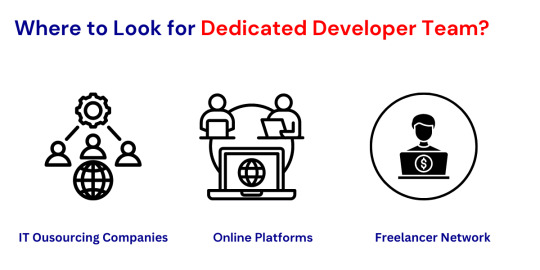
1. Early-stage Startups
For early-stage startups, bringing on a dedicated development team can be transformative. Startups often need to develop products swiftly while managing limited budgets. A dedicated team allows for rapid scaling of development efforts without the high costs associated with hiring in-house personnel. This approach also lets the in-house team concentrate on core business activities, while the dedicated team focuses on development work, resulting in faster product creation and reduced time-to-market.
2. Projects with Vague Requirements
When dealing with projects that have unclear or evolving requirements, a dedicated development team provides the flexibility necessary to navigate the discovery and development phases. These projects often require significant research, multiple iterations, and frequent adjustments based on feedback. A dedicated team offers the stability and resources to handle this fluidity, ensuring the project progresses smoothly without excessive spending or delays.
3. Long-Term Projects
Long-term projects benefit immensely from the consistent focus and commitment of a dedicated development team. Such projects typically demand sustained effort and a deep understanding of the project's objectives and intricacies. A dedicated team ensures continuity, builds accumulated knowledge over time, and adapts to changing needs, facilitating the achievement of long-term strategic goals.
4. Complex Projects
Enterprises undertaking complex projects with high technical demands and the need for ongoing collaboration can gain significantly from a dedicated team. This model ensures the team remains focused and aligned with the project's detailed requirements.
5. Variable Workloads
Companies facing fluctuating workloads can benefit from a dedicated team by scaling resources up or down as needed. This ensures efficient resource utilization without the complications of constant hiring and firing.
6. Specialized Skills
Projects that require niche technical expertise not readily available in-house can leverage a dedicated team to access a wide range of specialized talent. This ensures high-quality outcomes and innovative solutions.
These scenarios underscore the versatility and benefits of hiring a dedicated development team, making it a strategic choice for a variety of business needs and project types.
How to Build a Dedicated Development Team?
Where to Look for?
Finding the right dedicated development team is essential for your project's success. Here are some effective ways to locate one:
1. Outsourcing Companies
IT outsourcing companies provide a robust solution for hiring dedicated development teams. These companies have a pool of pre-vetted professionals and offer comprehensive management of the development process. They handle administrative tasks, maintain high-quality standards, and provide the flexibility to scale the team up or down as needed.
According to Clutch, 75% of companies that hired dedicated development teams reported improved project outcomes and higher satisfaction levels. This approach minimizes risks and maximizes efficiency, making it ideal for businesses looking to maintain control and ensure quality throughout the project lifecycle.
Example: Softlabs Group With over 20 years of experience and a presence in the USA, UK, Sweden, and India, Softlabs Group has completed over 5000 projects for clients in more than 25 countries. Their developers are known for their expertise, professionalism, and ability to deliver high-quality work within deadlines. Partnering with a reputable outsourcing company like Softlabs Group ensures you get dedicated developers who understand your project needs and can seamlessly integrate with your team.
2. Platforms
Various online platforms offer a wide range of remote developers, providing access to a global talent pool. However, these platforms often come with challenges such as variable quality and commitment levels.
Upwork: A widely used platform where you can find freelance developers. While it offers a large pool of talent, the quality can vary significantly, and it often requires sifting through numerous profiles to find a suitable candidate.
Toptal: Renowned for its rigorous screening process, Toptal provides access to top-tier developers. Although the quality is generally high, the costs can be substantially higher compared to other platforms.
LinkedIn: An excellent tool for networking and finding developers, LinkedIn allows for direct connections and in-depth profile reviews. However, filtering through profiles to find the right candidate can be time-consuming and requires careful vetting to ensure they meet your requirements.
3. Freelance Networks
Freelance networks and tech communities are valuable resources for finding developers, especially those who prefer freelance work over full-time employment. Here are some platforms to consider:
Freelancer.com: Similar to Upwork, Freelancer.com offers a large pool of freelance developers. However, the quality and commitment levels can vary, requiring thorough vetting to find the right candidate.
GitHub: This platform allows developers to showcase their work through repositories and contributions. It’s a great place to find developers with specific skill sets, but assessing their reliability and availability requires additional effort.
Stack Overflow Talent: This platform connects you with developers who are active in the tech community. While it’s a rich source of talent, it also demands careful evaluation of candidates to ensure they meet your project’s requirements.
Exploring these avenues can help you find skilled developers who fit your project needs. However, partnering with a reputable outsourcing company like Softlabs Group can offer a more streamlined and reliable solution, ensuring access to high-quality professionals with a proven track record.
What to Look for?
When hiring a dedicated development team, it is essential to consider several key factors to ensure you get the best fit for your project:
Technical Expertise: Look for a team with strong technical skills that match your project requirements. Evaluate their proficiency in the necessary programming languages, frameworks, and tools. Check their previous work and project portfolio to assess their capability to handle complex tasks and deliver high-quality results.
Communication Skills: Effective communication is crucial for the success of remote teams. Ensure that the team members can articulate their ideas clearly and understand your requirements. Good communication minimizes misunderstandings and promotes a collaborative environment. Utilize platforms like Slack, Microsoft Teams, or Zoom to maintain regular and clear communication channels.
Cost and Value Proposition: Assess the cost of hiring a dedicated developer team in relation to the value they bring to your project. While it’s important to stay within budget, the cheapest option is not always the best. Consider the overall value, including the team’s expertise, reliability, and ability to deliver on time. Compare rates from different regions and evaluate their cost-effectiveness relative to the quality of work they provide.
Project Management Skills: A dedicated team should possess strong project management skills to ensure smooth project execution. Evaluate their experience with project management methodologies like Agile or Scrum and their ability to use project management tools such as Jira or Trello. Effective project management ensures that timelines are met, and resources are used efficiently.
Culture Fit: Ensure the team aligns with your company’s culture and values. A good cultural fit can enhance collaboration and productivity. Look for a team that shares your work ethic, values, and professional norms. This alignment can lead to a more harmonious working relationship and better overall project outcomes.
By carefully considering these factors, you can select a dedicated development team that meets your project’s technical requirements and integrates well with your organizational culture and workflow. This approach will help ensure a successful and productive partnership.
How to Evaluate a Dedicated Development Team?
After defining your needs and identifying potential teams based on the outlined parameters, it’s crucial to evaluate them thoroughly. Here are key steps to ensure you choose the best team for your project:
1. Discuss Your Needs
Clearly outline your project requirements, including technical skills, project scope, timeline, and budget. This initial discussion ensures that potential teams understand your expectations and can assess their ability to meet your needs.
2. Review Portfolios and Case Studies
Examine the team’s portfolio to see examples of their previous work. Look for projects similar to yours in complexity and scope. Case studies provide insights into their problem-solving approach, technologies used, and the outcomes achieved. This review helps you gauge their experience and capability in handling projects like yours.
3. Select CVs for Key Roles
Request the CVs of team members who will be directly involved in your project. Review their educational background, certifications, and work experience to ensure they have the necessary expertise and relevant industry experience. This step helps you verify the qualifications of the individuals who will be crucial to your project’s success.
4. Conduct Interviews
Interview key team members to evaluate their technical skills and cultural fit. Ask about their previous projects, problem-solving approaches, and how they handle challenges. This helps ensure that they not only possess the technical capabilities but also align with your company’s values and work culture. Effective communication and a shared work ethic are vital for a productive partnership.
By following these steps, you can effectively evaluate and select a dedicated development team that is well-suited to your project’s specific requirements. This thorough evaluation process will help you build a strong, capable team that can deliver high-quality results and contribute to your project's success.
How to Manage a Dedicated Development Team?
Effectively managing a dedicated development team involves advanced strategies to ensure productivity, quality, and team engagement. Here are key areas to focus on:
1. Communication
Effective communication is the backbone of managing a global team. Regular meetings, clear communication channels, and asynchronous updates ensure everyone stays aligned, regardless of time zones.
Regular Meetings: Schedule daily or weekly meetings to keep everyone aligned.
Clear Channels: Use tools like Slack, Microsoft Teams, or Zoom for effective communication.
Asynchronous Communication: Utilize asynchronous updates to accommodate different time zones.
2. Workflow and Productivity
Task Management: Implement task management tools like Jira, Trello, or Asana to keep track of tasks and project progress.
Deep Work Sessions: Encourage uninterrupted work periods using techniques like Pomodoro to enhance focus and productivity.
Retrospectives: Hold regular retrospectives to identify and fix workflow issues, promoting continuous improvement.
3. Performance Monitoring
Metrics: Define and track performance metrics that align with project goals to ensure the team is on the right path.
Regular Reviews: Conduct quarterly performance reviews to provide feedback and set new goals, ensuring continuous growth.
Quality Assurance: Regularly update and maintain automated tests to ensure code quality and reliability.
4. Team Motivation and Engagement
Recognition: Acknowledge and celebrate team achievements to boost morale and motivation.
Growth Opportunities: Provide access to learning resources and varied tasks to promote professional development.
One-on-One Meetings: Hold individual meetings to address concerns, discuss career development, and build a strong rapport with team members.
5. Addressing Challenges
Proactive Problem-Solving: Regularly check for issues and use root cause analysis to address them promptly.
Clear Escalation Paths: Ensure there are clear paths for escalating unresolved issues to prevent bottlenecks.
Risk Assessments: Conduct periodic risk assessments and develop strategies to handle potential risks effectively.
6. Continuous Improvement
Feedback Loops: Set up ongoing feedback mechanisms for both processes and products to promote continuous improvement.
Innovation Time: Allow time for team members to experiment with new tools and ideas, fostering innovation.
Learning Sessions: Hold regular sessions where team members share knowledge and successful strategies, enhancing the team’s overall skill set.
By focusing on these key areas, managing your global dedicated development team can become more structured and efficient. This approach fosters a productive, motivated, and cohesive team ready to tackle any challenge.
Wrapping Up
By leveraging a dedicated team, businesses can maintain a sharp focus on core activities while ensuring high-quality outcomes in their development projects. Throughout this blog, we’ve explored the importance of dedicated development teams, the different models available, and the scenarios where hiring such a team makes the most sense. We’ve discussed how to build and manage a dedicated team, from selecting the right outsourcing partners and using various platforms to finding the best developers.
Partnering with a reputable outsourcing company like Softlabs Group further simplifies the process of managing and collaborating with a dedicated development team. Clutch reviews show that Softlabs Group has a client satisfaction rate of 92%, with clients praising their efficient communication, professionalism, and the quality of their work. Softlabs Group offers a streamlined approach with a pool of pre-vetted professionals, ensuring high-quality work delivered within deadlines.
n conclusion, hiring a dedicated development team can be a game-changer for businesses looking to enhance their digital capabilities while staying focused on their core functions. With the right partner, like Softlabs Group, companies can achieve their development goals efficiently and effectively, driving growth and innovation.
#DedicatedDevelopmentTeam#TeamBuilding#ProjectManagement#SoftwareDevelopment#RemoteTeams#AgileDevelopment#ITOutsourcing#TeamManagement#HiringDevelopers#DevelopmentTeam
0 notes
Text
Choosing the Right Development Team: In-House vs. Dedicated Developers
Introduction
Choosing the right development team is crucial for the success of any software project. The structure and capabilities of your team can significantly influence the project's efficiency, cost, and outcome. Whether to hire in-house developers or opt for dedicated developers is a key decision that businesses must make to align with their specific needs and goals.

In-house developers are employees who work full-time within your company, allowing for greater control and easier communication. On the other hand, dedicated developers are external professionals or teams hired specifically for a project, providing flexibility and access to a broader talent pool.
This blog aims to explore the pros and cons of each approach—hiring in-house developers versus dedicated developers—to help you make an informed decision that best suits your business requirements. By examining factors such as cost, control, scalability, and project management, we will provide a comprehensive comparison to guide your choice in building an efficient and effective software development team.
Understanding In-House Developers
Definition and Explanation of In-House Developers
In-house developers are full-time employees hired directly by a company to work on software development projects within the organization's premises. These developers are part of the internal IT team, contributing their skills and expertise to ongoing projects and initiatives.
Typical Scenarios Where Companies Prefer In-House Teams
Companies often prefer in-house teams when they require high levels of control and confidentiality over their software projects. Businesses working on core products that are central to their operations or those needing rapid iterations and direct communication may find in-house terms more beneficial. Additionally, companies focusing on long-term development projects or needing deep integration with other internal departments also lean towards in-house development.
Benefits of Having an In-House Development Team
Better Control and Communication: With in-house developers, managers can have direct oversight of the team's progress, ensuring that tasks are completed as expected. Face-to-face communication facilitates faster decision-making and problem-solving.
Stronger Alignment with Company Culture: In-house developers are more likely to understand and embody the company's values, mission, and culture, leading to better cohesion and team synergy.
Immediate Availability for Urgent Tasks: Having developers on-site means they can quickly address urgent issues or changes, ensuring minimal disruption to the project's timeline.
Understanding Dedicated Developers
Definition and Explanation of Dedicated Developers
Dedicated developers are professionals or teams provided by outsourcing companies to work exclusively on a client's software development project. These developers are not on the client's payroll but are engaged on a contractual basis, often for the duration of a specific project or for ongoing development needs.
Common Situations Where Dedicated Developers Are Utilized
Businesses frequently utilize dedicated developers when they need to rapidly expand their development capabilities without the long-term commitments associated with in-house hiring. Startups and growing companies often turn to dedicated developers to fill skill gaps or when launching new projects. Large enterprises might also use dedicated teams for specialized projects that require specific expertise not available internally.
Advantages of Hiring Dedicated Developers
Cost-Effectiveness: Engaging dedicated developers can be more budget-friendly than maintaining an in-house team, as it eliminates expenses related to salaries, benefits, and infrastructure. Companies can access high-quality talent without the long-term financial commitments.
Access to a Diverse Skill Set: Dedicated developers often bring a wide range of skills and experience from working on various projects across different industries. This diversity can be invaluable for tackling complex or specialized development tasks.
Flexibility and Scalability: Hiring dedicated developers allows companies to scale their teams up or down based on project demands. This flexibility ensures that businesses can adapt quickly to changing requirements and market conditions.
Detailed Comparison of In-House vs. Dedicated Developers
Cost
In-House Developers:
Initial and Ongoing Expenses: Hiring in-house developers involves significant upfront costs, including recruitment expenses, onboarding, salaries, and benefits (health insurance, retirement plans, etc.). Additionally, companies need to invest in office space, equipment, and software licenses.
Hidden Costs: Beyond the visible expenses, there are hidden costs such as continuous training, team-building activities, and employee retention strategies. High turnover rates can also add to the costs due to the need for frequent rehiring and retraining.
Dedicated Developers:
Initial and Ongoing Expenses: Engaging dedicated developers can be more cost-effective. Companies pay a predetermined fee, which usually covers all aspects of the developer's work, including tools and infrastructure provided by the outsourcing company.
Hidden Costs: While the direct costs are more predictable, there can be hidden costs related to managing the contract, potential miscommunication, and the need for additional quality assurance measures to ensure the work meets standards.
Quality and Expertise
In-House Developers:
Skill Levels: In-house developers are usually chosen through a rigorous recruitment process to ensure they meet the company’s standards. They have a deep understanding of the company’s products and processes.
Training and Development: Companies can invest in the continuous professional development of their in-house team, ensuring their skills remain up-to-date and aligned with the company's needs.
Dedicated Developers:
Skill Levels: Dedicated developers bring a broad range of experiences from working on various projects. This diverse expertise can be beneficial for projects requiring specific skills or innovative solutions.
Training and Development: Outsourcing companies typically handle the training and development of their dedicated developers, ensuring they stay current with industry trends and technologies.
Scalability
In-House Developers:
Ability to Expand or Reduce Team Size Quickly: Scaling an in-house team can be challenging and time-consuming due to the lengthy hiring and onboarding process. Reducing team size can also be difficult and may involve layoffs and associated costs.
Dedicated Developers:
Ability to Expand or Reduce Team Size Quickly: Dedicated teams offer high flexibility in scaling. Businesses can quickly increase or decrease team size based on project needs without the long-term commitments, making it easier to adapt to changing demands.
Management and Control
In-House Developers:
Direct Supervision: In-house teams offer greater control and direct supervision. Managers can closely monitor progress, provide immediate feedback, and ensure alignment with company standards.
Project Management: Having developers on-site allows for better integration with the project management framework and more effective collaboration with other departments.
Dedicated Developers:
Direct Supervision: There is less direct control over dedicated developers. Effective management relies on clear communication and robust project management tools.
Project Management: Managing remote teams requires additional effort in coordinating tasks, tracking progress, and ensuring timely delivery, often through digital tools and regular virtual meetings.
Flexibility
In-House Developers:
Adaptability to Project Changes: In-house teams can quickly adapt to project changes and urgent needs due to their immediate availability and deep understanding of the company's objectives.
Response to Urgent Needs: Having developers on-site means urgent tasks can be addressed promptly without delays caused by time zone differences or communication lags.
Dedicated Developers:
Adaptability to Project Changes: Dedicated developers offer flexibility in handling project changes, especially when the outsourcing contract includes provisions for scalability and adaptable skill sets.
Response to Urgent Needs: While dedicated developers can handle urgent needs effectively, time zone differences might sometimes cause delays in response times.
Communication
In-House Developers:
Ease and Frequency of Interactions: Face-to-face communication facilitates seamless interactions, quicker decision-making, and immediate problem resolution. This leads to more cohesive teamwork and efficient project progression.
Dedicated Developers:
Ease and Frequency of Interactions: Communication with dedicated developers primarily relies on digital channels, which can sometimes lead to misunderstandings or delays. However, with well-structured communication protocols and tools, these challenges can be mitigated effectively.
Conclusion
Choosing between in-house developers and dedicated developers is essential for the success of your software development projects. In-house developers offer better control, immediate availability, and alignment with company culture but come with higher development costs and limited scalability. Dedicated developers provide cost-effectiveness, diverse skills, and flexibility, although they may face communication challenges and offer less control.
Align your choice with your business goals, project requirements, and budget. Consider your needs for team management, developer efficiency, and the ability to adapt quickly to changes. By evaluating these factors, you can make an informed decision that optimizes your IT team for successful software projects.
Call to Action
Assess your development needs carefully to determine whether in-house or dedicated developers are the best fit for your software projects. Each approach has its own set of benefits and challenges, and aligning your choice with your business goals and project requirements is crucial.
We invite you to share your experiences or seek further advice by reaching out to our team. For professional guidance and to explore our comprehensive IT consulting and software development services, visit Softlabs Group. Our experts are ready to help you navigate your development options and find the most efficient solutions for your business needs. Contact us today to get started!
0 notes
Text
Ultimate Guide to Hiring Developers for Startups
Introduction
Hiring the right developers is crucial for startups. Developers transform ideas into reality, driving the success of the company. However, the wrong hire can lead to significant setbacks. Given the limited resources and time available, startups must adopt strategic approaches to hiring.

Challenges Unique to Startups in the Hiring Process
Startups face several unique challenges when hiring developers. Limited budgets make it difficult to compete with larger firms on salary and benefits. Every hire carries high stakes, significantly impacting the company’s trajectory. Additionally, startups often lack established hiring processes, making it harder to attract and retain top talent. Convincing skilled developers to join a startup can be challenging, as can maintaining their engagement through a culture of innovation and growth. Understanding these challenges is the first step toward building a strong, effective team.
Understanding Your Needs
Identifying the Required Skills and Technologies
To streamline the hiring process, it's essential to identify the exact skills and technologies your startup requires. Determine the core technologies that are vital to your projects, such as specific programming languages and tools. Decide on the experience level needed—whether junior, mid-level, or senior developers—and identify any specialized skills required for niche areas like AI or mobile development.
Determining the Type of Developer
Choosing the right type of developer is critical. Frontend developers are experts in user interfaces, working with HTML, CSS, and JavaScript. Backend developers handle server-side logic and databases, using technologies like Node.js and Python. Full-stack developers are versatile, capable of working on both front-end and back-end tasks. Defining these roles clearly ensures that each developer's focus area is understood, responsibilities are allocated based on strengths, and expectations for teamwork and communication are set.
Crafting an Attractive Job Description
Key Elements of an Effective Job Description
An effective job description is clear and compelling, crucial for attracting top talent. Begin with a concise job title and summary, clearly stating the role and providing a brief overview. List the main responsibilities and duties, detailing the necessary skills and experience required. Mention the competitive salary, benefits, and unique perks your startup offers to make the position more attractive.
Highlighting Startup Culture and Benefits
To stand out, showcase what makes your startup unique. Describe your company culture and values, emphasizing any flexible working conditions such as remote work options. Highlight unique benefits like team-building activities, a relaxed dress code, or stock options. These elements can make your startup more appealing to potential candidates.
Including Growth Opportunities and Learning Prospects
Emphasize the opportunities for growth and learning within your company. Outline potential career paths, detailing how employees can advance within the company. Mention professional development opportunities such as workshops, conferences, and courses. Highlight any mentorship programs or chances to work closely with industry leaders, which can be particularly appealing to top talent.
Sourcing Candidates
Utilizing Job Boards and Online Platforms
Maximize your reach by using popular job boards and online platforms. LinkedIn is an excellent tool for posting job openings and actively searching for potential candidates. GitHub is a valuable resource for exploring repositories to find developers with relevant skills. Utilize job boards like Indeed, Glassdoor, and AngelList, which are tailored for startups, to broaden your search.
Leveraging Networking and Referrals
Tap into your network and encourage referrals to find qualified candidates. Incentivize your current team to refer potential hires. Reach out to industry contacts and alumni networks and share job postings on social media platforms like Twitter, Facebook, and LinkedIn.
Engaging with Developer Communities and Meetups
Connecting with developers in their own spaces can be highly effective. Participate in forums like Stack Overflow and Reddit, and attend local meetups, hackathons, and tech conferences to meet potential hires. Contributing to or sponsoring open-source projects can also help you connect with active developers.
Screening and Shortlisting
Reviewing Resumes and Portfolios
Carefully review candidates' resumes and portfolios, focusing on relevant experience, necessary technical skills, and past projects. This helps gauge their expertise and creativity.
Conducting Initial Phone or Video Interviews
Conduct initial interviews to narrow down your list of candidates. Ask about their experience with specific technologies and projects, assess their problem-solving abilities through hypothetical scenarios, and evaluate their communication skills and professionalism.
Assessing Cultural Fit
Ensuring candidates align with your startup’s culture is essential. Discuss their values and work ethic, consider how they would fit into your existing team, and evaluate their ability to thrive in a fast-paced, changing environment.
Technical Assessment
Designing Coding Challenges and Technical Tests
Create effective coding challenges that reflect real tasks they will face in the role. Include tasks of varying difficulty to assess different skill levels and use platforms like Hacker Rank or Codility for efficient and fair assessments.
Conducting Technical Interviews
Conduct in-depth technical interviews to further assess candidates. Present complex problems to solve in real-time, ask candidates to review and improve existing code snippets, and test their understanding of key concepts and best practices.
Utilizing Pair Programming Sessions
Pair programming sessions allow you to observe candidates in a collaborative environment. Work on actual problems your team faces, assess their ability to work effectively with others, and observe how they articulate their thought process and solutions.
Evaluating Soft Skills
Importance of Communication and Collaboration
Effective communication and collaboration are essential in a startup environment. Assess candidates' ability to articulate ideas, explain technical concepts, and work well with others, including developers, designers, and stakeholders. Observe how they handle constructive criticism and feedback.
Assessing Problem-solving and Critical Thinking
Determine candidates' problem-solving and critical thinking abilities through scenario-based questions, analytical thinking exercises, and questions that require logical reasoning and innovative solutions.
Evaluating Adaptability and Learning Agility
Adaptability and learning agility are crucial for thriving in a dynamic startup environment. Assess candidates' willingness and ability to adapt to changing requirements, their enthusiasm for learning new skills and technologies, and discuss situations where they had to quickly learn and adapt to new challenges.
Making the Offer
In the competitive startup ecosystem, making a compelling offer is crucial. Startups must balance limited resources with the need to attract top talent. Offering a competitive salary is a baseline expectation, but startups often cannot compete with established companies solely on salary. This is where equity options come into play. By offering equity, startups provide potential employees with a stake in the company's future success, aligning their interests with the company's growth.
Research industry standards and competitor offerings to ensure your salary ranges are competitive. Clearly explain the equity offering, including vesting schedules and potential future value. Consider adding performance-based bonuses that reward employees for meeting specific milestones, providing an additional financial incentive.
Onboarding Process
An effective onboarding process ensures new employees feel welcomed, valued, and prepared to contribute. For startups, this is even more essential as they need new hires to hit the ground running.
Begin the onboarding process before the first day by sending a welcome package with company information, swag, and a personalized welcome note. Plan a detailed first-day schedule that includes introductions to key team members, a tour of the office (or virtual introductions if remote), and an overview of the company culture and values. Develop a comprehensive onboarding timeline that spans the first 90 days (about 3 months), including regular check-ins, feedback sessions, and milestone assessments.
Integrating new developers smoothly into the team is crucial for maintaining productivity and team cohesion. Assign a mentor or a buddy to help navigate the company's codebase, workflows, and culture. Facilitate introductions through team meetings, one-on-one sessions, and social activities. Encourage pair programming sessions to help new developers get up to speed with the codebase and collaborate closely with existing team members.
Provide new hires with access to all necessary tools and platforms from day one. Ensure they have clear documentation on how to set up the development environment and access to internal documentation, coding standards, and best practices.
Retention Strategies
Retaining top talent is crucial for the sustained success of any startup. Effective retention strategies help maintain a motivated, engaged, and productive workforce.
Building a Positive Work Environment
A positive work environment fosters employee satisfaction and loyalty, reducing turnover rates. Encourage transparent and open communication across all levels of the organization, promote a healthy work-life balance, and cultivate an inclusive and diverse workplace where all employees feel valued and respected.
Continuous Learning and Development Opportunities
Providing continuous learning and development opportunities is a key driver of employee engagement and retention. Invest in professional development programs, offer tuition reimbursement for further education, and encourage internal mobility by offering employees opportunities to move into different roles or departments.
Regular Feedback and Performance Reviews
Regular feedback and performance reviews are essential for employee development and satisfaction. Conduct regular one-on-one meetings between employees and managers to discuss progress, challenges, and goals. Implement structured performance reviews at least biannually and incorporate 360-degree feedback into the review process.
Conclusion
In this guide, we’ve covered essential aspects of hiring and retaining top talent in a startup environment. From crafting compelling job descriptions and making attractive offers to onboarding and retention strategies, each step plays a critical role in building a strong and dynamic team. With these strategies in hand, you are well-equipped to start the hiring process with confidence. Focus on creating a compelling offer, ensuring a smooth onboarding experience, and implementing effective retention strategies to build a talented and dedicated team that will drive your startup towards success.
0 notes
Text
Maximizing Business Efficiency: The Benefits of Hiring Remote Developers
In the current dynamic digital environment, business operations are swiftly transforming, with remote hiring emerging as a pivotal element of contemporary workforce strategies. A study conducted by Stanford University reveals that companies implementing remote work policies can achieve a productivity boost of up to 13%. This blog is dedicated to exploring the advantages of employing dedicated developers and how this approach can drastically improve your business efficiency.

By accessing a global talent pool, lowering operational expenses, and promoting innovation, embracing remote work can revolutionize your organization. Continue reading to uncover powerful data and insights that will change your perspective on hiring and productivity.
Businesses That Can Benefit from Hiring Remote Developers
Remote developers bring specialized skills and flexibility, making them valuable assets for various industries. Here’s how different sectors can leverage remote talent to spur innovation and growth. From technology to e-commerce, remote talent is revolutionizing businesses globally.
1. Technology
Companies in software development, IT services, and cybersecurity can significantly benefit from remote developers by accessing specialized skills and rapidly scaling projects.
Benefits: Access to specialized skills and quick project scaling.
Statistics:
Growth: The global IT outsourcing market is projected to grow at a CAGR of 4.5% from 2021 to 2026.
Demand: Approximately 70% of tech companies hire remote developers to meet project demands.
2. Finance
Financial institutions can utilize remote developers to create secure financial software and enhance online banking services.
Benefits: Development of secure financial software and enhancement of online banking services.
Statistics:
Growth: The global fintech market size is forecasted to reach USD 644.6 billion by 2029, growing from USD 209.7 billion in 2024 at a CAGR of 25.18%.
Security: About 60% of financial services firms employ remote developers for cybersecurity improvements.
Example: Nippon India, one of India’s largest asset management companies, collaborated with Softlabs Group to develop a Trail Brokerage Management System using Dot Net Core, React JS, and SQL.
Testimonial: "Softlabs Group’s service and results have proven highly successful for us. Their team excels in clear and consistent communication, ensuring that project details are conveyed effectively. What truly stands out is their commitment to building long-term working relationships, going beyond immediate project goals. This dedication not only fosters a positive collaboration environment but also sets the stage for continued success in future endeavors."
3. Healthcare
Telehealth platforms and health tech companies can benefit from remote developers for innovating and maintaining their digital solutions.
Benefits: Innovation and maintenance of digital solutions.
Statistics:
Growth: The global telehealth market is expected to grow at a CAGR of 24.0% from 2020 to 2027.
Adoption: Around 80% of health tech startups employ remote developers for app development.
4. E-commerce
E-commerce businesses can enhance their platforms and improve customer experiences with the help of remote developers.
Benefits: Platform enhancement and customer experience improvement.
Statistics:
Growth: In 2023, global retail e-commerce sales reached an estimated $5.8 trillion, with projections indicating a 39% growth in the coming years.
Demand: On average, 65% of e-commerce companies hire remote developers to optimize their platforms.
Remote Developers vs. Onsite Developers
Remote developers provide greater flexibility, cost-effectiveness, and access to a wider talent pool compared to onsite developers. They eliminate geographical constraints, reduce overhead costs, and offer diverse skill sets. This comparison helps businesses determine which model aligns best with their operational needs and goals.
Benefits of Hiring Remote Software Developers
Understanding the benefits of hiring remote developers can help businesses make informed decisions and optimize their operations. Here are some key advantages:
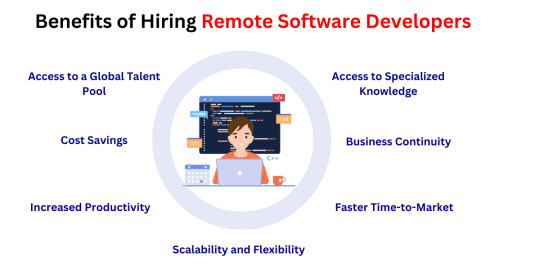
1. Access to a Global Talent Pool
Diverse Skills and Expertise: Companies can tap into a worldwide talent pool, gaining access to specialized skills and knowledge that may not be available locally.
Enhanced Innovation: A diverse team brings varied perspectives and innovative solutions to complex problems.
2. Cost Savings
Lower Overhead Costs: By hiring remote developers, businesses can save on expenses related to office space, utilities, and in-house amenities.
Geographical Cost Differences: Remote developers from regions with lower living costs can offer the same level of expertise at a fraction of the cost compared to local hires.
3. Increased Productivity
Flexible Work Hours: Remote developers often have the flexibility to work during their most productive hours, leading to higher efficiency.
Reduced Commute Stress: Eliminating the daily commute can reduce stress and increase the amount of time developers can dedicate to work.
4. Scalability and Flexibility
On-Demand Scaling: Businesses can easily scale their development teams up or down based on project needs without the constraints of long-term employment contracts.
Adaptability: Remote teams can quickly adapt to changing project requirements and deadlines.
5. Faster Time-to-Market
Round-the-Clock Development: With developers in different time zones, projects can progress continuously, reducing overall development time.
Quick Hiring Process: The ability to hire from a global pool means finding the right talent quickly, speeding up project initiation and execution.
6. Access to Specialized Knowledge
Niche Expertise: Remote hiring allows businesses to bring in experts with niche skills required for specific projects, enhancing the quality and innovativeness of the solutions.
Continuous Learning: Remote developers often have access to a variety of learning resources and networks, ensuring they stay updated with the latest technologies and trends.
7. Business Continuity
Disaster Recovery: Remote teams provide continuity in case of local disruptions, ensuring that business operations can continue uninterrupted.
Scalable Infrastructure: Cloud-based tools and infrastructure support remote work, making it easier to maintain and scale operations.
These practical benefits demonstrate how hiring remote software developers can significantly boost business efficiency, driving growth, innovation, and cost-effectiveness.
Mistakes to Avoid While Hiring Remote Developers
Here’s a list of common mistakes to avoid while hiring remote software developers.
1. Inadequate Communication Channels
Mistake: Relying only on email can cause misunderstandings and delays.
Solution: Use a variety of communication tools to ensure clarity and efficiency. For instance:
Slack for instant messaging.
Zoom for video conferencing.
Trello for project management.
2. Poor Onboarding Process
Mistake: Skipping proper onboarding leads to confusion and low productivity.
Solution: Develop a comprehensive onboarding plan that includes:
Detailed introductions to company processes and tools.
Introductions to team members.
Providing necessary resources and training materials to new hires.
3. Lack of Clear Expectations
Mistake: Not setting clear goals and deadlines can cause misalignment and poor results.
Solution: Clearly define project goals, deliverables, and timelines. Use project management tools like:
Asana or Jira to track progress and maintain accountability.
Regular check-ins to ensure alignment and address any issues promptly.
4. Ignoring Time Zone Differences
Mistake: Overlooking time zones can cause coordination issues.
Solution: Establish overlapping working hours and use scheduling tools for meetings. When setting deadlines, consider the following:
Utilize tools like World Time Buddy to manage time zone differences.
Be flexible with meeting times to accommodate all team members.
5. Neglecting Team Integration
Mistake: Treating remote developers as separate from the main team can lower morale.
Solution: Ensure remote developers feel included by:
Inviting them to all team meetings and activities.
Encouraging virtual team-building exercises to build rapport and a sense of belonging.
Avoiding these common mistakes can help you effectively integrate remote developers into your team, ensuring smooth collaboration and optimal productivity.
6. Overlooking Cultural Differences
Mistake: Ignoring cultural differences can lead to miscommunication and misunderstandings.
Solution: Be aware of and respect cultural differences. Promote an inclusive work environment by:
Providing cultural sensitivity training.
Encouraging open discussions about cultural norms and practices.
7. Failing to Monitor Performance Regularly
Mistake: Not regularly monitoring performance can lead to missed deadlines and unmet goals.
Solution: Implement regular performance reviews and feedback sessions. Use tools like:
15Five or Lattice for continuous performance management.
Set clear performance metrics and regularly review them.
8. Not Providing Growth Opportunities
Mistake: Overlooking professional development can result in low motivation and high turnover.
Solution: Offer growth opportunities by:
Providing access to online courses and training programs.
Encouraging participation in conferences and webinars.
By being mindful of these additional considerations, you can create a more cohesive and motivated remote development team.
Conclusion
Avoiding these common mistakes will help you seamlessly integrate remote developers into your team. Prioritize effective communication, thorough onboarding, clear expectations, respect for time zones, and inclusive team integration to ensure smooth collaboration and optimal productivity. Additionally, acknowledging cultural differences, monitoring performance, and providing growth opportunities will foster a supportive and thriving remote work environment.
Over to You!
Embracing remote developers can be a transformative strategy for your business, offering substantial benefits such as cost savings, increased productivity, and access to a global talent pool. By leveraging specialized skills from around the world, your company can innovate faster, adapt to changing market demands, and maintain a competitive edge.
At Softlabs Group, we understand the power of remote work and offer dedicated developers to help you achieve your business goals. Whether you’re looking to scale your development team, access niche expertise, or enhance your digital solutions, our experienced developers are here to support you.
Ready to boost your business efficiency with dedicated remote developers? Click here to start hiring now.
By partnering with us, you can:
Scale Your Team Efficiently: Quickly add skilled developers to your team to meet project demands.
Access Niche Expertise: Tap into a global talent pool to find developers with the specific skills you need.
Enhance Digital Solutions: Improve your digital products and services with the help of our experienced developers.
Stay Competitive: Innovate faster and adapt to market changes to maintain a competitive edge in your industry.
Our commitment to quality and seamless integration ensures that our remote developers will be valuable additions to your team. Let's take the next step towards achieving your business goals together.
If you have any questions or need more information, feel free to contact us. We're here to help you succeed in the digital age.
0 notes